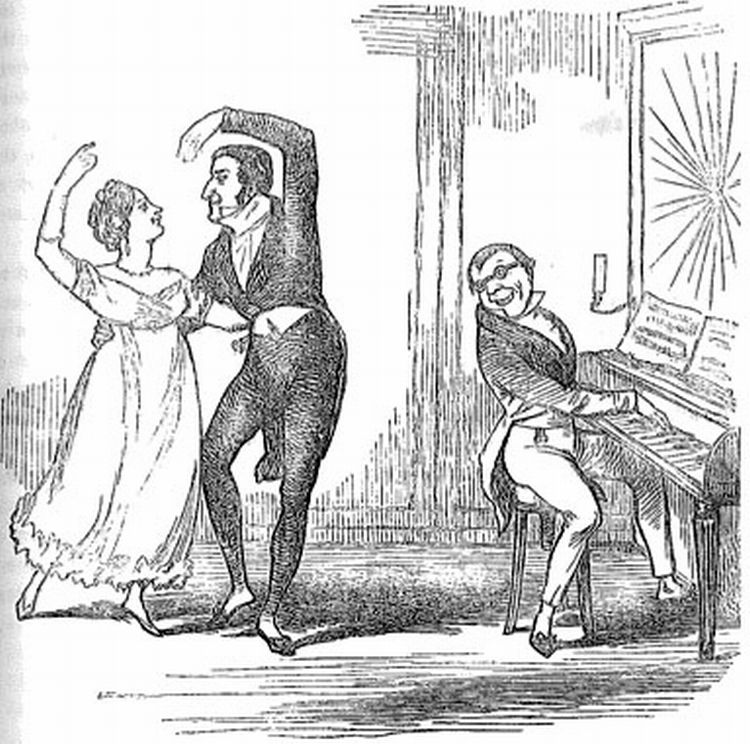[I am grateful to Simon During, Eric Eisner, Jim Epstein, Jared Gardner, Tom Laqueur, Roxann Wheeler, and, as always, Rebecca Morton for their encouragement and smart questions during the rather protracted gestation of this essay. I owe a particular debt to Franco Moretti, not only for giving me a chance to try out an earlier version of this project as a guest in his seminar on “The Enigma of Victorianism,” but also—and more importantly—for reintroducing me to the profound pleasures of map-making (which had mysteriously slipped out of my life after early adolescence).
The sources of the various prints here reproduced are all given in their respective captions. The background for all the maps is taken from Christopher and John Greenwood, MAP of LONDON FROM AN ACTUAL SURVEY IN THE YEARS 1824, 1825 & 1826 (London, 1830). Courtesy of Motco Enterprises Limited.]
When William Makepeace Thackeray looked back at his youth, he was more than a little bewildered by the ways in which he’d gotten caught up in the single greatest cultural craze of his boyhood: the mania surrounding Pierce Egan’s Life in London; or, the Day and Night Scenes of Jerry Hawthorn, Esq., and his Elegant Friend Corinthian Tom, Accompanied by Bob Logic, the Oxonian, in their Rambles and Sprees through the Metropolis. Thackeray readily granted that the illustrations which Robert and George Cruikshank had done for the book had not lost their appeal over the intervening decades: “the pictures!—oh! the pictures are noble still!” And he fondly reminisced about “what a funny fellow that actor was who performed Dicky Green in ... the play!” ( “De Juventute” 510). But “on reperusal, Tom and Jerry is not so brilliant as I had supposed it to be... the style of the writing ... was not pleasing to me; I even thought it a little vulgar ... and as a description of the sports and amusements of London in the ancient times,” Life in London now seemed “more curious than amusing” (509-10). Even the typography had grown cryptic: “those inverted commas, those italics, those capitals” must have been “as good as jokes, though you mayn’t quite perceive the point” anymore (511). Indeed, twenty years earlier, Thackeray had been unable to remember “the literary contents of the book” at all: they had “passed sheer away,” even as the “scenes remain[ed] indelibly engraved upon the mind” (rev. of The Tower 13). Yet despite his retrospective bafflement as to the attractions of Egan’s writing, Thackeray was nonetheless firmly convinced that Life in London’s account of the larks of a fashionable young man (Tom), his country cousin (Jerry), and their friend Logic, a witty Oxford student, through the gamut of metropolitan life somehow embodied its age and so, more than any other touchstone from those years, could conjure up “the antediluvian world” before “railways were made,” when there was “an enjoyment of life ... which contrasts strangely with our feelings of 1860,” now that “every London man is weary and blasé” ( “De Juventute,” 505, 503, 510).
Considered in isolation, Thackeray’s insistence upon the puzzling exemplarity of Life in London might come off as simply the half-amused nostalgia of a middle-aged man: engaging, perhaps, but not necessarily all that revealing. However, Thackeray’s confusion seems to have been broadly shared with his contemporaries. Charles Mackay, for example, cited the time that “people went mad upon a dramatic subject, and nothing was to be heard of but ‘Tom and Jerry’” as one of the “Popular Follies in Great Cities”: “every youth on the town was seized with the fierce desire of distinguishing himself, by knocking down the ‘charlies,’ being locked up all night in a watch-house, or kicking up a row among loose women and blackguard men in the low dens of St. Giles’s” (336-37). Further examples could be adduced, but the pattern seems clear: those old enough to remember the reign of George IV were retrospectively perplexed by the appeal of Life in London, but utterly certain that that appeal, whatever it may have been, epitomized something important about the early 1820s, what R. S. Surtees would tellingly term “the old Tom-and-Jerry days, when fisticuffs were the fashion” (187).
And so its popularity would suggest: Egan’s biographer records that “so great was the demand for copies of the numbers [in which Life in London was originally published] that the printers ... could hardly keep pace with it, and whole armies of women and small boys, employed to colour the plates, were worked to exhaustion” (Reid 73). Before the initial serialization was even complete, the earlier parts were reprinted at a higher price, to be followed by at least five other editions before the end of the decade.
Nor was “all London” content to “read it,” they also, as Thackeray recalled, “went to see it in its dramatic shape” (rev. of The Tower 13).
At least ten different metropolitan theaters offered plays based upon Life in London in the 1821-22 and 1822-23 seasons. Indeed, at several points in the spring and summer of 1822 one could take in up to eight competing productions, the most popular of which—W. T. Moncrieff’s Tom and Jerry—ran for an unprecedented three hundred nights: “from the highest to the lowest, all classes were alike anxious to witness its representation; Dukes and Dustmen were equally interested in its performance, and Peers might be seen mobbing it with Apprentices to obtain an admission. Seats were sold for weeks before they could be occupied.... In the furor of its popularity, persons have been known to travel post from the furthest parts of the kingdom to see it; and five guineas have been offered in an evening for a single seat” (Moncrieff 1826, v).
Nor was this an exclusively London phenomenon: over the next few years, performances (usually of Moncrieff’s version) were staged in Birmingham, Bridgnorth, Brighton, Cheltenham, Dublin, Edinburgh, Glasgow, Hull, Lincoln, Liverpool, Newark, Newcastle, Redruth, Shrewsbury, and Southampton, not to mention the even more far flung theaters of Albany, Baltimore, Boston, Charleston, Montreal, New Orleans, New York, Philadelphia, York, Upper Canada, and even Sydney. Opportunistic booksellers quickly commissioned a range of imitations, including Life in St. George’s Fields, Real Life in London, and Female Life in London (the latter was simply a reprint of Frances Burney’s Evelina). The ballad publisher James Catnach offered several different broadside redactions, while countless cordials, dances, dinners, fans, games, handkerchiefs, porcelain figures, prints, screens, slang dictionaries, snuffboxes, song books, sweetmeats, tea boards, and toy theater sheets were produced for those who wished to include Tom and Jerry in their daily rituals.
Even the clothing trades got in on the act. According to John Camden Hotten, “tailors, bootmakers, and hatters recommended nothing but Corinthian shapes and Tom and Jerry patterns” (10) and at least some of their recommendations carried all the way across the Atlantic: in Richmond, Virginia, the young Edgar Allen Poe singled out a romantic rival’s “Tom and Jerry brim / And dove-tailed coat, obtained at cost” for particular mockery (11). Clearly something about Life in London resonated with a broad cross-section of the reading, theatrical, and consumer publics of the early 1820s.
Yet what that something was seems to have already become semi-incomprehensible by the 1840s and that incomprehensibility only increased as the century wore on until even the foremost chronicler of the craze was forced to confess that “although Life in London ... did make our grandfathers so very—very! merry in the first quarter of the Nineteenth Century, we are constrained to admit; that it is a terrible dull and tedious work to read through in the present day.” Indeed, “the present generation will find in some of the scenes depicted in such glowing colours, many of the fashions, manners, and customs, which prevailed in the reign of King George the Fourth, together with certain landmarks of the past, which no one need regret leaving far behind, and ought to give every encouragement to those who live under the rule of Queen Victoria to maintain a firm faith in the social progress of the age” (Hindley ii-iii, iv). Whatever significance Life in London still had lay in what Hotten termed “its value as a true picture of life fifty years ago”: “the last days of coarse caricatures, of dueling, and of the glorious three-bottle system after dinner” (9).
Most of the extant scholarship on Egan and the Cruikshanks has simply replicated this pattern of being convinced that the success of Life in London was somehow emblematic of its age (the Cruikshank prints have been used to illustrate dozens of books on the Regency and reign of George IV), yet finding it incredibly difficult to specify what its appeal might have been, other than as a vague—and generally unconvincing—adumbration of another, supposedly more readily comprehensible phenomenon like The Pickwick Papers or the flâneur or Bakhtinian heteroglossia. Even the best critics (who recognize that Life in London was “a summation of the passing culture ..., not a foretaste of the new” and so really shouldn’t be folded into the longue durée of Victorianism) seem to be unable to explain the sheer magnitude of the craze: why such “low-life fantasies” should have gone supernova in the first half of the 1820s, rather than simply faded away (Gatrell 552, 555).
Clearly this is a problem for the history of reading and theatergoing and ordinarily I would turn to the letters, diaries, and marginalia of Egan’s contemporaries in order to try to reconstruct how Life in London might actually have been read and watched. Alas, such evidence seems to be more than usually scarce in this case and that which I have found—such as John Clare’s suggestion that Byron’s Don Juan “seems a fit partner for Tom & Jerry” (34) or Harriet Arbuthnot’s dismay at how the audience at a performance of Moncrieff’s version “seemed to enjoy a representation of scenes in which, from their appearance, one might infer they frequently shared” (144)—come off, at least initially, as even more idiosyncratic or blinkered than such traces generally are.
Rather than throw up my hands at the absence of our customary tools, however, I decided to try something of a methodological experiment. Intrigued by Franco Moretti’s assertion that “the most profoundly social aspect of literature is its form” ( “Preface” xii) and suspecting that the difficulty which previous scholars had had in explaining the appeal of Life in London stemmed at least in part from the temporal breadth of their inquiries—the nineteenth-century novel, the eighteenth-century “urban odyssey,” late Georgian urban pleasure, even simply “Regency London” (which still takes in a full decade)—I decided to map out, Moretti-like, Life in London part by monthly part, and then dramatic adaptation by dramatic adaptation, in order to see if those maps could reveal anything more specific to the early 1820s about the appeal of these texts to readers and playgoers. My hope was that by figuring out how these texts unfolded both temporally and spatially and how that unfolding was in turn related to the probable time and place of their reading or viewing, I could discern something about the “social aspect” of their form which was otherwise unavailable for scrutiny. In so doing, I fondly imagined, I might finally be able to devise a way to combine a proper consideration of form with the history of reading and theatergoing—a consummation which I, at least, have long devoutly wished.
The results of my mapping Life in London were a revelation and immediately illuminated a number of puzzles which the other scholarship I had read had been unable to solve to my satisfaction. The patterns which emerged from this mapping (and, I think, their significance) were then confirmed by the maps which I made of the most successful dramatic adaptations and by what evidence exists regarding the reactions of early readers and playgoers. Put most baldly, the formal elements which best explain the mania spawned by Life in London come from those parts of the book which appeared before the narrative, such as it is, ever got going. Accordingly, any attempt to account for the power of Life in London by theorizing how its narrative works is almost automatically going to lead us astray: quite simply, it would be looking in the wrong place. Whatever Life in London may be, it’s not ultimately a nineteenth-century novel in which plot and the fate of emplotted characters are the fundamental sources of interest and power.
So what did I find when I did my mapping? First let me highlight a small, but extremely telling detail, one which can serve as a key to unlock the significance of what the maps reveal: a note headed “SECOND EDITION, JAN. 8, 1821,” which Egan added to retract his playful banter in the first edition with Friedrich Christian Accum, now that the latter had been caught tearing leaves out of a library book at the Royal Institution.
Accum’s misplaced zeal for knowledge (in an age before photocopying, he wanted to take an article on chocolate home with him) doesn’t matter for our purposes. But Egan’s mention of a second edition in early January 1821 is huge, since producing such entailed reprinting and again hand-coloring both the text and the plates for the already extent Parts One through Five of Life in London and raising the price of those reprinted parts and all of the remaining installments from two-and-a-half shillings apiece to three. Bibliographers and collectors of the Cruikshanks have long known of this second edition and would readily concede how unprecedented it was. Quite simply, illustrated books at this price point had never sold so quickly as to necessitate more than a single edition while the original serialization was still underway. Even The Tour of Doctor Syntax, which largely created the market for such books, didn’t go into a second edition until its initial appearance in The Poetical Magazine was complete.
However, no one has apparently ever thought through the significance of what this second edition reveals: namely, that Life in London was astonishingly successful by a few days after the release of Part Five. Yet, if we look at what has happened in the text to that point, we get almost nothing by our usual novelistic standards. Those first five parts are comprised almost exclusively of an extended pitch for the importance of “seeing Life,” along with character sketches of Logic, Tom, and Jerry. The first episode remotely close to actual narrative (certainly the first event which the Cruikshanks deem worthy of illustration) is only half finished by the close of Part Five—just a week before the second edition. Prior to that, nothing happens. Or, to be precise, none of the events which figure in the illustrations or Victorian memory have yet occurred by that point in the text (a good forty-two percent of the way in).
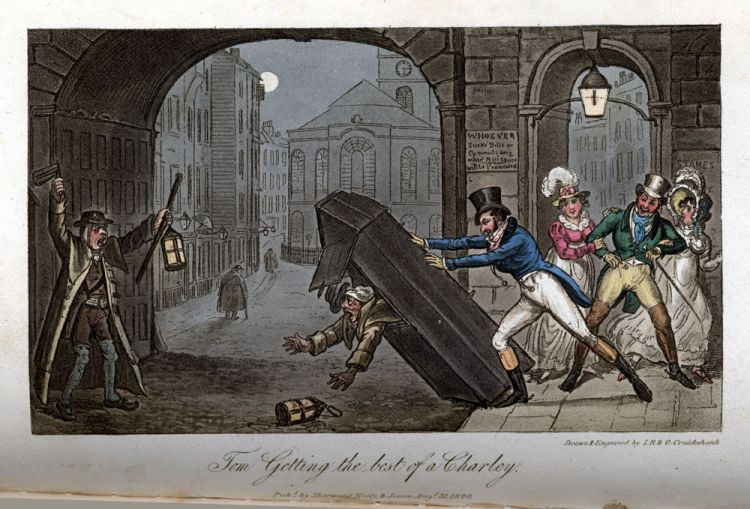
Fig. 1 Robert and George Cruikshank, “Tom Getting the best of a Charley,” Life in London; or, the Day and Night Scenes of Jerry Hawthorn, Esq., and his Elegant Friend Corinthian Tom, Accompanied by Bob Logic, the Oxonian, in their Rambles and Sprees through the Metropolis (London, 1820-21). Courtesy of The Ohio State University Rare Books and Manuscripts Library.
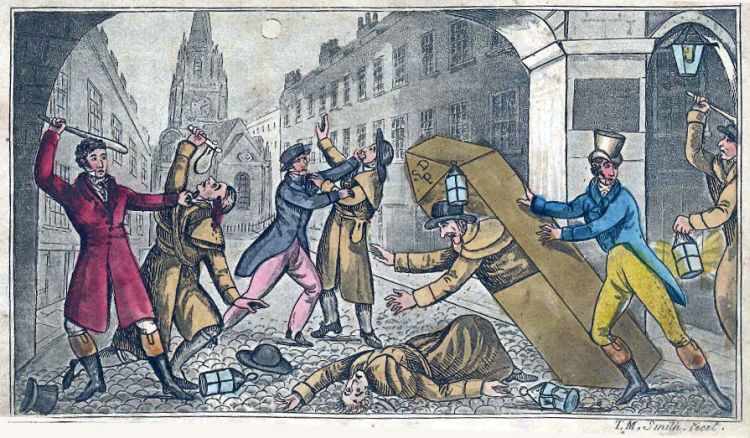
Fig. 2 Frontispiece to Life in London, or The Adventures of Jerry Hawthorn, Who, from a Chaw-bacon, became a first rate Dandy of the Milling Order; Corinthian Tom, His accomplished London Cousin; and Bob Logic, A Friend of the latter, particularly fond of knocking down the Charlies; Giving a full Account of all their Larks, Sprees, Rows, Rambles, and other frolics; Being a faithful Portraiture of High & Low Life, from Almack’s in the West, to All-Max in the East (London, n.d. [c. 1822]). Courtesy of the University of Cincinnati Library.
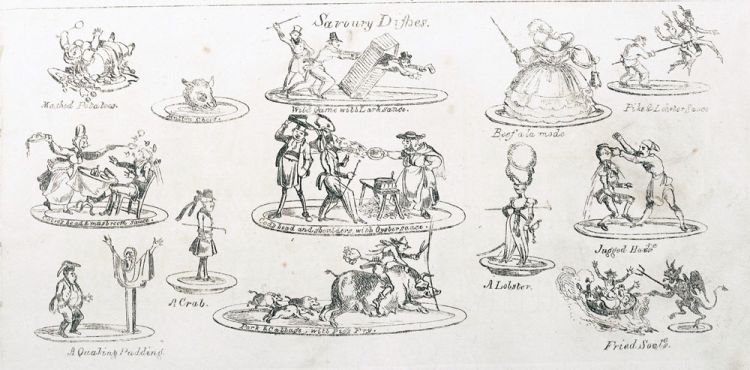
Fig. 3 “Wild Game with Lark sauce” from “Savoury Dishes,” Northern Looking Glass 1.17 (1826): 64. Courtesy of The Ohio State University Cartoon Library and Museum.
On the other hand, readers had already gotten fifteen plates (three in each part), including many of the ones which would go on to be the most iconic: say, “Tom Getting the Best of a Charley” (figure 1) which was adapted for various downmarket redactions of the text (figure 2), taken up as a general visual joke (figure 3), and transfer-printed onto a handkerchief to delight “the Country Folks” (Egan, Pierce Egan’s Finish 11-12). Compare the maps in the slideshows below for the text and the plates (in each case the locales which appear in the part in question are shown in yellow, while sites from earlier parts are in red):
SLIDESHOW ONE
SLIDESHOW TWO
In the first four parts of the text, as I’ve just suggested, there’s almost nothing in terms of narrative, and what little there is in Part Five hardly involves much in the way of “rambles and sprees”: Jerry begins to get fitted for new clothes at Tom’s elegant house in the West End. With the plates, on the other hand, our heroes travel all over the West End and Covent Garden, indulging themselves in various sorts of sports, gambling, slumming, and other larks, including dalliances with both their mistresses and the prostitutes who haunt the theater. What possible sense can this disparity make? Even if the narrative existed only to flesh out the plates (as was sometimes charged to be the case by later partisans of the Cruikshanks) and so necessarily had to lag behind, surely a practiced journalist like Egan wouldn’t have needed three whole months to get to the action.
Unless, of course, getting to the action wasn’t really the point. I’d like to propose that this disparity between the text and plates, far from being either irrelevant or a clumsy bit of throat-clearing on Egan’s part while he figured out what to do, can actually go quite far toward explaining the astonishing appeal of those early parts of Life in London, whose success brought the text to “the tipping point” where it could cross over into a full-scale sensation (after which the usual feedback loops of commercial success and “extraordinary popular delusions” could kick in).
So let’s turn to those early parts and consider how their seemingly mismatched text and plates might actually have worked together.
The first thing to notice is how sustained and (in its own way) systematic a pitch for its own aesthetics we are offered. According to Egan, the grand object of this work is an attempt to portray what is termed ‘SEEING LIFE’ in all its various bearings upon society, from the high-mettled CORINTHIAN of St. James’s, swaddled in luxury, down to the needy FLUE-FAKER of Wapping, born without a shirt, and not a bit of scran in his cup to allay his piteous cravings. ‘LIFE IN LONDON’ is the sport in view, and provided the chase is turned to a good account, ‘seeing Life’ will be found to have its advantages ... whether an evening is spent over a bottle of champaign, at Long’s, or in taking a ‘third of a daffy’ at Tom Belchers’s... Equally so, in waltzing with the angelics at my Lady FUBB’S assembly, at Almack’s, or sporting a toe at Mrs. SNOOK’S hop at St. Kit’s, among the pretty straw damsels and dashing chippers, if a knowledge of ‘Life,’ an acquaintance with character, and the importance of comparison, are the ultimate results. (24)
“Seeing life” thus seems to involve appreciating both the marked social and geographic variety of the metropolis and the underlying similarity of pleasures which yokes such variety together into a coherent, if pointedly not unified vision of “Life in London.” For those able to relish it, “a blow out may likewise be found as savory and as high scented at Mother O’Shaughnessy’s, in the back settlements of the Holy Land, by the hungry cut-away Paddy Mulroony, as the Mulligatawny soup may be swallowed with peculiar goût by one of the fastidious, squeamish, screwed-up descendants of the OGILBY train at Grillion’s hotel” (26-27). Or, to put it differently, as Egan clearly delights in doing, “hundreds of individuals in the Metropolis think it no loss of time, and feel as much interest in matching their tykes at JEM ROLFE’S amphitheatre for a quid or two; or in drawing the badger at HARLEQUIN BILLY’S menagerie, and boasting of the goodness and breed of their dogs, as MY Lord CARE-FOR-NOTHING does in relating the pedigree of his high-mettled cattle, and talking with the touters and jockeys at Newmarket” (34). Once one comprehends “the advantages resulting from the varieties of ‘LIFE’” (29), one can supposedly acquire a sort of universal comfort akin to that of Tom, who “was as much at home in blowing a cloud, listening to a night-row charge at a watch-house, as he proved himself an adept in all the luxuriant, voluptuous movements, when waltzing at Almack’s (42).
I quote so extensively in order to demonstrate the ways in which Egan’s style enacts the very aesthetics he’s championing: like life in London itself by Egan’s account, Life in London jumbles together seemingly disparate kinds of people, sorts of places, and perhaps above all varieties of language (and typography) in order to bring out their putative underlying similarity and the advantages of learning to be comfortable amidst them all. If “half of the world are up to” “the slang” he introduces, “it is my intention to make the other half down to it. LIFE IN LONDON demands this sort of demonstration. A kind of cant phraseology is current from one end of the Metropolis to the other” and so needs to be replicated in order to properly render “real Life” (84-85n) and so equip his readers with the tools to emulate his hero, Richard Brinsley Sheridan: “a man at all times, whether viewed at dashing routs, surrounded by the most accomplished beauties; or caught upon the sly, peeping at midnight revels in the precincts of Covent Garden” (16). Those beauties might talk “of ‘a row’ which occurred ... last evening,” while the Covent Garden revelers would allude to a “lark... at a gin-spinner’s,” but, for Egan, slang was “as strongly marked” (84-85n) in St. James’s as it was in St. Giles and it was only from “the knowledge and experience” of both that one might attain “complete possession” (75) of one’s self.
Of course, inevitably, there will be a gap between any representation and its object and Egan not only knows this, but highlights it again and again as a source of potential pleasure. Early on, he insists upon the adequacy of his representations: he’s offering “his readers a Camera Obscura View” through which LIFE IN LONDON will be seen without any fear or apprehension of danger either from fire or water; avoiding also breaking a limb, receiving a black eye, losing a pocket-book, and getting into a watch-house; picking up a Cyprian and being exposed the next morning before a magistrate for being found disorderly. Likewise in steering clear of all those innumerable rows and troubles incident or allied to ‘keeping it up, and loving of fun.’ It would have been fortunate indeed for poor JERRY and CORINTHIAN TOM if they had possessed such advantages. But ‘experience makes fools wise,’ and as good-natured HAWTHORN and laughing TOM are now about to relate their adventures, for the benefit of fire-side heroes and sprightly maidens, who may feel a wish to ‘see Life’ without receiving a scratch, it must be considered that the Metropolis is now before them. (19)
Tom and Jerry are thus, it would seem, perfectly up to the job of “seeing Life” on behalf of these “fire-side heroes and sprightly maidens,” who need not go out, Adam and Eve-like, into the metropolis “now before them” in order to “benefit” from it. Rather they can simply sit back and appreciate the splendor of its variety: after all, “POUSSIN never had a more luxuriant, variegated, and interesting subject for a landscape; nor had SIR JOSHUA REYNOLDS finer portraits for his canvass than what have already had a sitting for their likenesses to embellish LIFE IN LONDON” (17). Yet only three months later, as the text was on the verge of finally plunging into those “adventures,” these same heroes and maidens got to witness Tom telling Jerry that “volumes would not suffice to portray the various characters which cross our path DAILY in LONDON. A theoretical inquiry will not go far enough in ascertaining the real features of society in the Metropolis. You are now on the primest SPOT in all the world.... I would, therefore, advise you to make the best use of your time. I have seen a great deal of LIFE myself; but I have a great deal yet to see!” (143). If even Tom has “a great deal yet to see” and “a theoretical inquiry” will not suffice, then it would seem that representation of the sort which Egan is offering up will not ultimately prove sufficient: those heroes and maidens would have to leave their firesides and risk injury or embarrassment if they wished to actually “see Life.” Yet this insistence upon the inadequacy of representation doesn’t simply supercede or cancel out the previous claims of adequacy. Rather, the two seem to coexist, albeit uneasily: a relationship nicely encapsulated by the sheer repetition of phrases like “such is the diversity of LIFE IN LONDON” (30) or “it is a multum in parvo trait of “Life in London” ” (139n), the ambiguity of whose reference—the book? the city? both?—at once collapses and maintains the distinction between Egan’s text and the metropolis itself.
I dwell on these questions of the adequacy of representation—which, I think, are repeated so insistently as to be nearly inescapable, even for rather distractible readers, as most of the early adopters of Life in London probably were—because they help to explain the workings of the plates in these early parts and how their interaction with these questions helped bring this book to the tipping point. For one thing, the plates themselves supposedly share the text’s paradoxical blend of strict mimesis and adherence to artistic convention. In the note on slang I quoted earlier, Egan goes on to suggest that “my ingenious friends, ROBERT and GEORGE CRUIKSHANK, whose talents in representing ‘the living manners as they rise,’ stand unrivalled in this peculiar line, feel as strongly impressed with the value of delicacy as I do. But if some of the plates should appear rather warm, the purchasers of Life in London may feel assured, that nothing is added to them tending to excite, but, on the contrary, they have most anxiously, on all occasions given the preference rather to ‘extenuate’ than to ‘set down aught in malice.’ All the Plates are the exact representations, as they occurred, of the various classes of society” (85n). And while it would probably be impossible to determine whether any particular image has been extenuated or exactly represented (or somehow both at once), the plates do stylistically bear out this odd betwixt and betweeness.
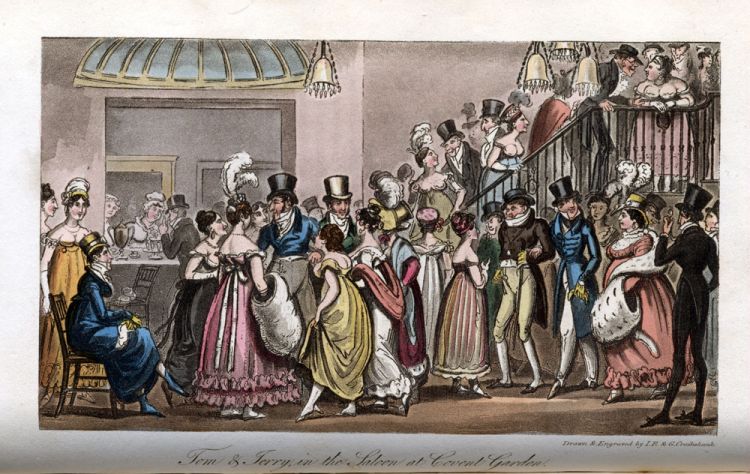
Fig. 4 Robert and George Cruikshank, “Tom & Jerry in the Saloon at Covent Garden,” Life in London; or, the Day and Night Scenes of Jerry Hawthorn, Esq., and his Elegant Friend Corinthian Tom, Accompanied by Bob Logic, the Oxonian, in their Rambles and Sprees through the Metropolis (London, 1820-21). Courtesy of The Ohio State University Rare Books and Manuscripts Library.
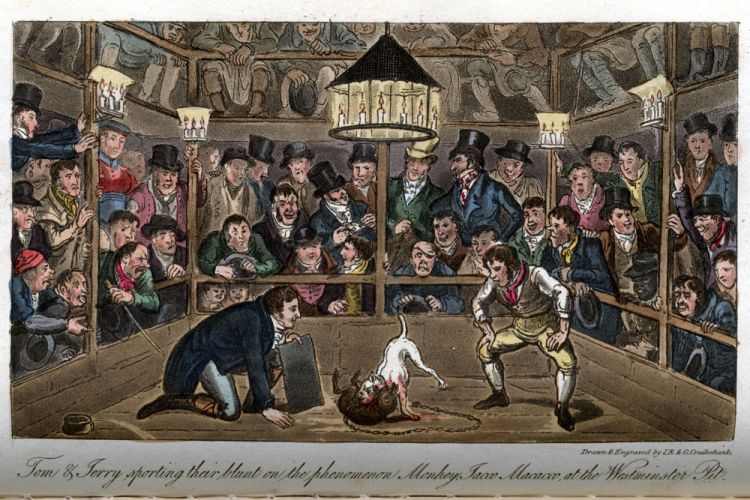
Fig. 5 Robert and George Cruikshank, “Tom & Jerry sporting their blunt on the phenomenon Monkey Jacco Macacco at the Westminster Pit,” Life in London; or, the Day and Night Scenes of Jerry Hawthorn, Esq., and his Elegant Friend Corinthian Tom, Accompanied by Bob Logic, the Oxonian, in their Rambles and Sprees through the Metropolis (London, 1820-21). Courtesy of The Ohio State University Rare Books and Manuscripts Library.
On one hand, they offer what seem (on the basis of other evidence we have) to be quite accurate renderings of their various locales. The saloon at Covent Garden (see figure 4) or the Westminster Pit (figure 5) did, so far as we can tell, look the way the Cruikshanks pictured them, in terms of their architecture, the rank and dress of their usual denizens, etc. On the other hand, however, these same images look almost exactly like any number of other hand-colored aquatint caricatures of the early nineteenth century with their shallow box-like rooms, foreshortened perspective, grotesque faces, visual jokes (like the rather phallic muff in front of Tom’s breeches in the saloon at Covent Garden), etc.
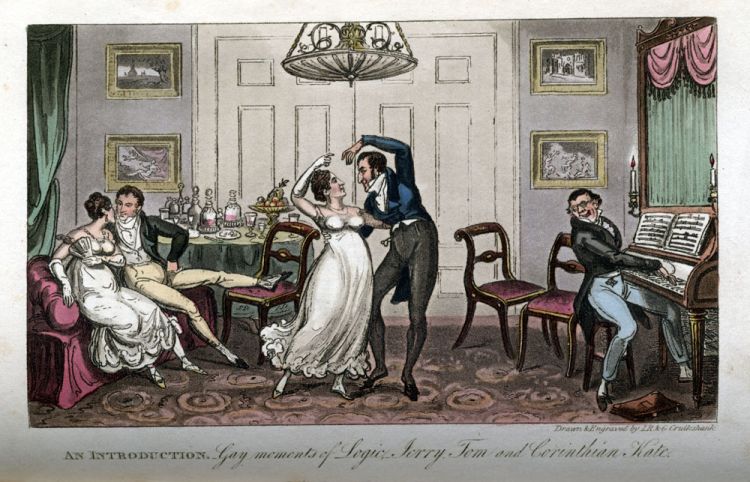
Fig. 6 Robert and George Cruikshank, “AN INTRODUCTION. Gay moments of Logic, Jerry, Tom and Corinthian Kate,” Life in London; or, the Day and Night Scenes of Jerry Hawthorn, Esq., and his Elegant Friend Corinthian Tom, Accompanied by Bob Logic, the Oxonian, in their Rambles and Sprees through the Metropolis (London, 1820-21). Courtesy of The Ohio State University Rare Books and Manuscripts Library.
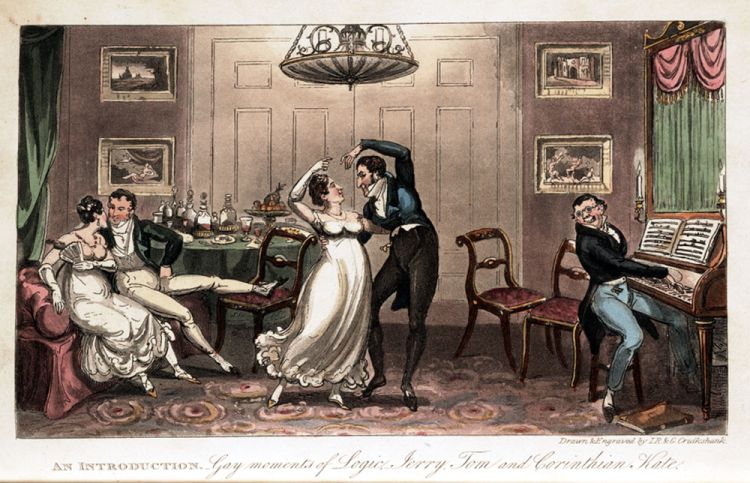
Fig. 7 Robert and George Cruikshank, “AN INTRODUCTION. Gay moments of Logic, Jerry, Tom and Corinthian Kate,” Life in London; or, the Day and Night Scenes of Jerry Hawthorn, Esq., and his Elegant Friend Corinthian Tom, Accompanied by Bob Logic, the Oxonian, in their Rambles and Sprees through the Metropolis (London, 1820-21). Courtesy of the San Francisco Academy of Comic Art Collection, The Ohio State University Cartoon Library and Museum.
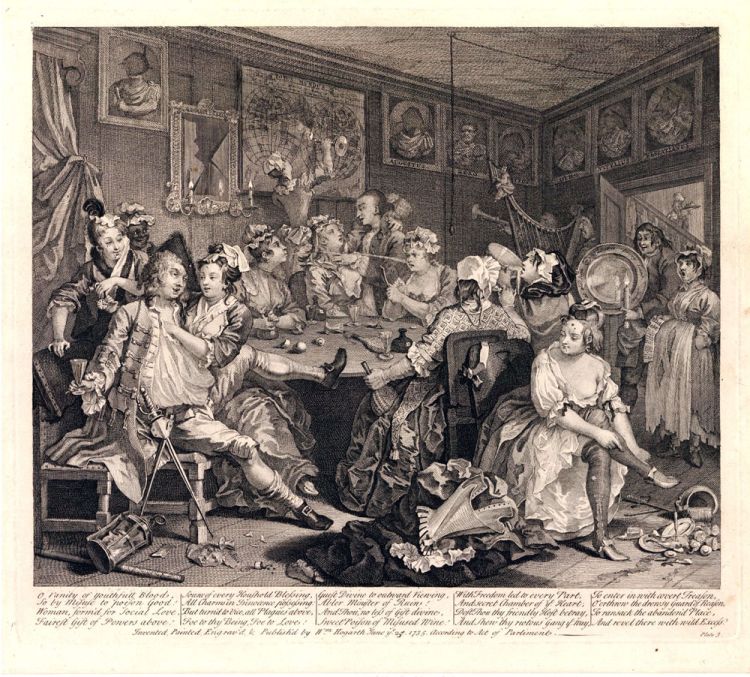
Fig. 8 William Hogarth, A Rake’s Progress, Plate Three (London, 1735). Courtesy of The Trustees of the British Museum.
Moreover, if readers compared their respective copies of Life in London (as many print collectors were wont to do) they would have noticed variations between the copies that seem far from random. For example, one Ohio State copy of the plate which most struck Thackeray—“An Introduction. Gay moments of Logic, Jerry, Tom, and Corinthian Kate”—showed Jerry’s mistress with her breasts covered (figure 6), while another of our copies left them bare (figure 7), so as to call attention to the fact that Kate and Sue are, after all, “cyprians” and that Jerry’s pose is straight out of the brothel scene in The Rake’s Progress .
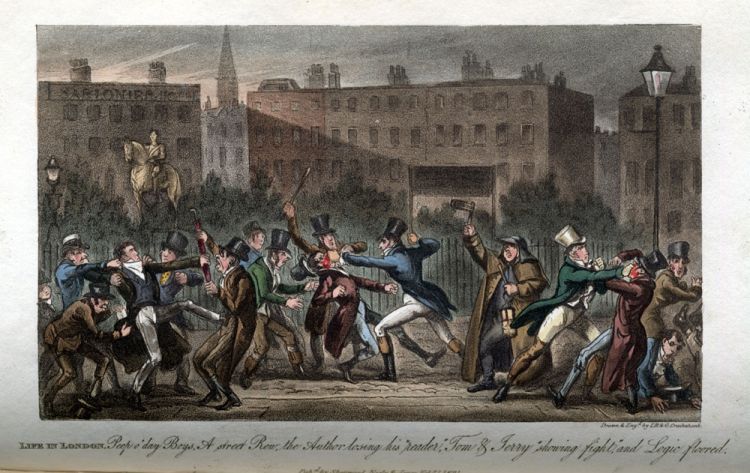
Fig. 10 Robert and George Cruikshank, “LIFE IN LONDON. Peep o’day Boys. A street Row, the Author losing his reader, Tom & Jerry “showing fight,” and Logic floored,” Life in London; or, the Day and Night Scenes of Jerry Hawthorn, Esq., and his Elegant Friend Corinthian Tom, Accompanied by Bob Logic, the Oxonian, in their Rambles and Sprees through the Metropolis (London, 1820-21). Courtesy of The Ohio State University Rare Books and Manuscripts Library.
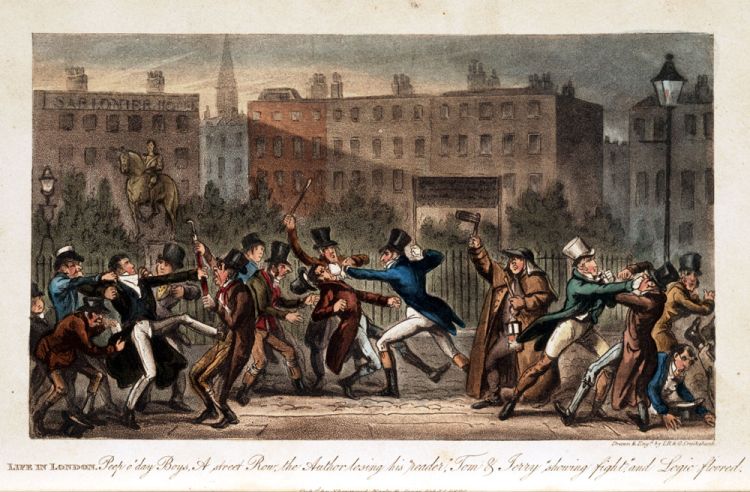
Fig. 11 Robert and George Cruikshank, “LIFE IN LONDON. Peep o’day Boys. A street Row, the Author losing his reader, Tom & Jerry “showing fight,” and Logic floored,” Life in London; or, the Day and Night Scenes of Jerry Hawthorn, Esq., and his Elegant Friend Corinthian Tom, Accompanied by Bob Logic, the Oxonian, in their Rambles and Sprees through the Metropolis (London, 1820-21). Courtesy of the San Francisco Academy of Comic Art Collection, The Ohio State University Cartoon Library and Museum.
A similar variation can be seen in a plate from Part Six (which appeared a few weeks after the tipping point, but the note “TO THE SUBSCRIBERS” from “THE AUTHOR IN DISTRESS!” inserted to explain the brevity of Part Five had hinted at this scene): in one copy Tom and Jerry’s punches in “a street Row” are landing hard enough to draw blood, in another they’re not. Obviously these variations undercut the sustainability of any claim to catch “‘the living manners as they rise.’” Were these scenes wholly mimetic, then surely one of these copies would have to be wrong: at the moment represented, Sue’s breasts were either covered or uncovered, just as Tom’s fist did or did not smash his opponent’s nose. But the very impossibility (and ridiculousness) of even trying to ascertain the truth here only underscores what I think is the broader project of these plates within the aesthetics of representational adequacy and inadequacy that I’ve been sketching out.
If the point of the text of the first five parts of Life in London is to learn how to “see Life,” then the plates in those parts are offering up specimens of “Life” to be seen. That is, they are offering the promise of narrativity. They aren’t yet narrative (we don’t know how our heroes got into these situations, nor what will come next, nor even in what sequence these various episodes will occur and whether or not that sequence is significant). Rather, they’re a sign that “the Rambles and Sprees through the Metropolis” which the wrappers of each part promise are, in fact, on the way, that at some point soon we will learn what was involved in Tom’s “accommodat[ing] himself, as much as possible, to the dispositions of the company in which he might be situated” (110). But given the uncertainty of how adequate these plates ultimately are as representations, I’d like to suggest that the anticipated narrativity of “seeing Life” is, dare I say it, always already divided.
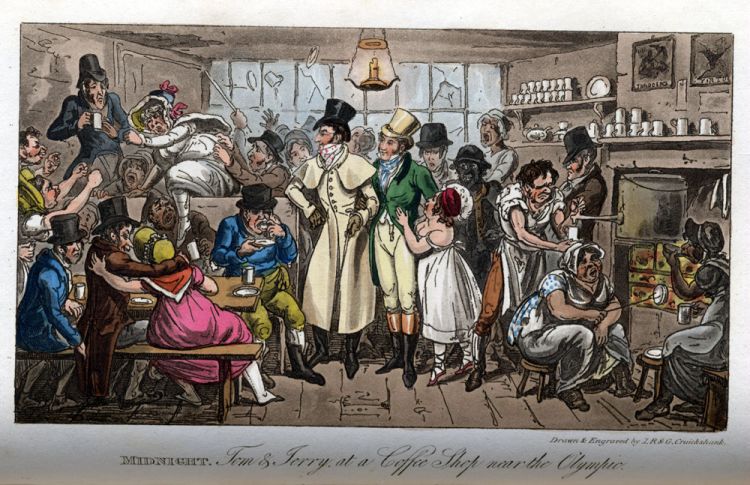
Fig. 12 Robert and George Cruikshank, “MIDNIGHT. Tom & Jerry at a Coffee Shop near the Olympic,” Life in London; or, the Day and Night Scenes of Jerry Hawthorn, Esq., and his Elegant Friend Corinthian Tom, Accompanied by Bob Logic, the Oxonian, in their Rambles and Sprees through the Metropolis (London, 1820-21). Courtesy of The Ohio State University Rare Books and Manuscripts Library.
“Fire-side heroes and sprightly maidens” couldn’t be sure if the breasts of fashionable cyprians were routinely bared during private performances of what Egan later termed “the elegant but lascivious waltz” (196), any more than they could be sure that coffee shops near the Olympic Theatre routinely degenerated into late night comic riots (see figure 12). But they also couldn’t be sure that they didn’t ... unless they went out to see for themselves.
“Seeing Life” can thus go in two quite different directions: one could wait to “see” the episodes depicted in the plates as they eventually unfolded (in the months after the tipping point of the second edition). Or one could go out into the metropolis in pursuit of what one hoped would be similar adventures. Both solutions seem to have been engaged in. On the one hand, in a note on the wrappers for Part Four, Egan let his “Subscribers” know that “in consequence of several applications having been made to the Publishers respecting the EXPLANATIONS OF THE PLATES, it is necessary to observe, that they are merely given ... to keep the plates alive; but the subjects of them will be more minutely described, in their proper place in the body of the work,” which would suggest a certain readerly impatience for the plates’ promise of narrativity to be fulfilled. On the other hand, though, as Roger Sales has pointed out, readers are “given enough information to plan their own rambles” (161) and over the next few years the press would repeatedly claim that they were doing just that with a vengeance: by one report, there were “nineteen watchmen prostrate with their boxes on their backs” in April 1822 alone ( “Annus Mirabilis!” 23).
Similarly, in December of that year three “dashing young gentlemen” were charged “with making a ‘Tom-Jerry-and-Logic’ row, after midnight, near St. Thomas’s Hospital” in Southwark. Among other things, they were “crying ‘Go it, Jerry!’—‘Go it, Tom!’—‘Go it, Logic!’ &c. One of them said ‘now we’ll floor the d—d Charley.’ They then ran with great force against his watch-box, and endeavoured to upset it, so as to inclose him inside of it.” An alderman said “not a night elapsed but that in some part of the town the peace was broken by young thoughtless fellows apeing ‘Tom, Jerry, and Logic’” (Glasgow Herald, presumably reprinting an item from an unidentified London paper).
Obviously these particular accounts postdate the specific months in late 1820 and early 1821 we’ve been examining—and attribute these pranks to “the Tom and Jerry fever extending to all the minor theatres” ( “Annus Mirabilis!” 23)—but I see no reason to presume that some sort of readerly sprees were not already being undertaken during the serialization of the first five parts. Certainly the geography of those early parts, along with the apparently intended readership and the peculiar temporality of serial reading, solicits such excursions—if only to ascertain the adequacy or inadequacy of Life in London’s representation. Consider the spatial distribution of the places depicted in the plates of the first five numbers.
SLIDESHOW THREE
Six are in the fashionable West End (Tom’s apartment, the Westminster Pit, Corinthian Kate’s apartment, Rotten Row, Jackson’s rooms in Bond Street, and a game of whist played near St. James’s park). The other nine, however, are in the rather more socially varied area surrounding Covent Garden (Temple Bar, a coffee shop near the Olympic Theatre, a watchhouse near Bow Street, the English Opera House, Covent Garden Theatre, Bow Street itself, a fortune teller’s house near Russell Street, a gin shop near Covent Garden Theatre, and the tavern run by the retired boxing champion, Tom Cribb, near the Haymarket). And even if a reader didn’t know exactly where a specific place was located, the two areas of town are quite visually and thematically distinct from one another and so it would have been easy enough to figure out the approximate neighborhood in question. West of Regent Street we get fine clothing and sports and gambling and high-end courtesans like Corinthian Kate and Sue. East of Regent Street we get larks and their consequences, slumming, masquerade, various sorts of drinking, and a more ordinary species of prostitute. To some extent, of course, such a spatial division of London was nothing new—even if the construction of Regent Street had significantly bolstered it by “damming up Soho” (Summerson 125). But I suspect the division was particularly resonant for the target public for Life in London, which, given the fairly steep price of the book (and its apparent absence from most circulating libraries), probably constituted a good chunk of its actual readership.
In his lengthy invocation, Egan singles out three businesses which he hopes will help make Life in London a success: the bookshops of Henry Colburn and John Murray and the printshop of George Humphrey. Colburn will, Egan wishes, inform “those dashing belles and beaux, whose morning lounge gives thy repository of the mind an air of fashion, that LIFE IN LONDON is worthy of their perusal,” while Murray, whose “splendid threshold” frightens away the “pale, wan, and shabbily clad,” will “take the unsophisticated JERRY HAWTHORN by the hand” and “introduce him to thy numerous acquaintance.” And if Humphrey will allot “only one little pane of glass in thy attractive shop-front ... for the display of CORINTHIAN TOM, ... he may be viewed quite ‘at home’ in St. James’s Street” (8). As these invocations should suggest, these are the most fashionable purveyors of print in the metropolis and, I think tellingly, they’re all located in the neighborhood in which Tom, Jerry, and Logic reside. Obviously this need not mean that all of the early readers of Life in London either patronized those shops or lived in that neighborhood, but it seems probable that if they didn’t, they thought themselves in the minority (i.e., they presumed that most of the other “fire-side heroes and sprightly maidens” being addressed were one and the same with the “dashing belles and beaux” who lounged into Colburn’s).
Why should this sort of speculative sociology of readers matter? Compare the locations of these shops with the geography of the plates in the first five parts.
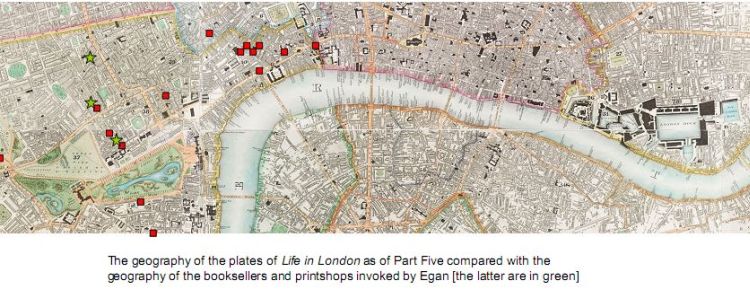
If I’m correct in my presumptions, then most of the early readers were living and lounging on the other side of Regent Street from the majority of the promised narrativity. Moreover, the intensity of that felt separation from the anticipated “rambles and sprees” would have been magnified, perhaps exponentially, by the seriality of part publication. As Thomas Arnold would note twenty years later, “works of amusement ... published periodically” “occupy the mind” longer than works published all at once and so “keep alive” a “constant ... expectation,” “thus dwelling upon the mind, and distilling themselves into it as it were drop by drop” until they “possess it so largely, colouring even, in many instances, its very language, and affording frequent matter for discussion” (39). It doesn’t take anywhere close to a month to read a thirty-two-page octavo pamphlet and its printed wrapper, nor to look at three plates. Yet the readers whose demand took Life in London to the tipping point had to wait at least that long to get the next part and if they were drawn in by any of the promised narrativity, their wait could be considerably longer before that promise was fulfilled. As my maps should suggest, the sprees depicted in the plates of the double installment of October 1820 did not begin to be narrated until at least January 1821 and in most cases, February or March or even, in the case of “Tom Getting the Best of a Charley,” April of that year. In the meantime, readers had to go about their own lives in London, either musing on the adequacy of Egan’s account of the “rambles and sprees” which lay on the other side of Regent Street or else setting out on their own such adventures—which might or might not accord with the account Egan eventually provides. Either way, though, the effect would be a complex entanglement of Life in London with life in London such that the aesthetics of “seeing Life” and the questions of representational adequacy which they pose would almost have to have become phenomenologically central to those readers’ lives. Like the realisms described by D. A. Miller, although presumably without quite the same disciplinary force, this interpenetration would “ensure that the novel is always centrally about the world to which one will be recalled and that the world to which one will be recalled has been reduced to attesting the truth (or falsehood) of the novel” (83). Hence, it’s not so much that “the sprawling, rambling form of Life in London ... reproduc[es] the form of the city itself” (Sales 156) as that the form of Life in London solicits and shapes a particular way of “seeing Life” which then becomes wholly intertwined with the “Life” to be seen, both in the text and plates to come and in the city itself.
Thus far I’ve been dwelling upon the very beginnings of the craze for Life in London, what took the phenomenon to the tipping point of an unprecedented second edition and price increase while the initial serialization was still underway. But most of the mania postdates this second edition: the assorted reprints of Life in London as a stand-alone volume, the various theatrical versions, the Catnach broadsides and other opportunistic redactions, the consumer goods ... these are all part of later 1821 or 1822 or 1823. Why spend so much time on the readers of these early parts, whose total numbers must have been dwarfed by those who got swept up in the craze after early January 1821? The answer, I’d like to propose, is that the rest of the phenomenon largely plays out according to the parameters set by these first few parts and their early adopters. This is not to say that nothing changes, of course, but the subsequent parts of Life in London itself, the theatrical versions, and all of the other evidence that I’ve been able to uncover all suggest that they were working within the same aesthetics of “seeing Life” and the same questions of representational adequacy that we’ve been reconstructing.
Consider, for example, the ways in which Egan and the Cruikshanks continued to solicit readerly curiosity as to the adequacy of their representations. We are repeatedly told, in the parts published after the tipping point, that we can place our trust in the reliability of their depictions: the scene at Jackson’s Rooms “is most accurately represented” (216), and so can serve as as much of a surrogate for the rooms themselves as the scene at Cribb’s Parlour, even though Jackson’s “is not common to the public eye.... no person can be admitted without an introduction” (217), while Cribb’s “can be seen at all times, and, therefore ... may be identified when any person thinks proper” (220). Yet we are also told that scenes like that of the ginshop near Covent Garden “may be nightly witnessed after the SPELL is dissolved: but in much more depraved colours than is here represented” (180) and that “neither the PEN nor the PENCIL, however directed by talent, can do ... adequate justice” to “the Morning of Execution” at Newgate “or convey a description of the ‘harrowed feelings’ of the few spectators that are admitted into the Condemned Yard upon such an occasion” (280-81). And even when the promised narrativity finally began to arrive, more often than not it was a bit coy and still inclined to toy with the temporality of serial reading. So, for example, in the long-anticipated account of “Tom Getting the best of a Charley” (see again figure one) we are explicitly told that the women on Jerry’s arms were, as most readers probably already suspected, “a couple of Cyprians” (232) who, after the prank, and “in the most tender and persuasive manner, ... endeavoured to gammon JERRY and the CORINTHIAN up Shire-Lane to a place of safety, as they termed it” (233). Tom declined the invitation to their house, but we are pointedly not informed whether they made alternate arrangements: “it is quite immaterial how our heroes eluded the pursuit of the Charleys, or in what manner they spent the remainder of the night; they were out on a ‘spree,’ and were determined to finish it. They were not immaculate,” although whatever transpired couldn’t have been too dire, as “LOGIC found his companions” at home and “in a ‘whole skin’ ... the next morning” (233).
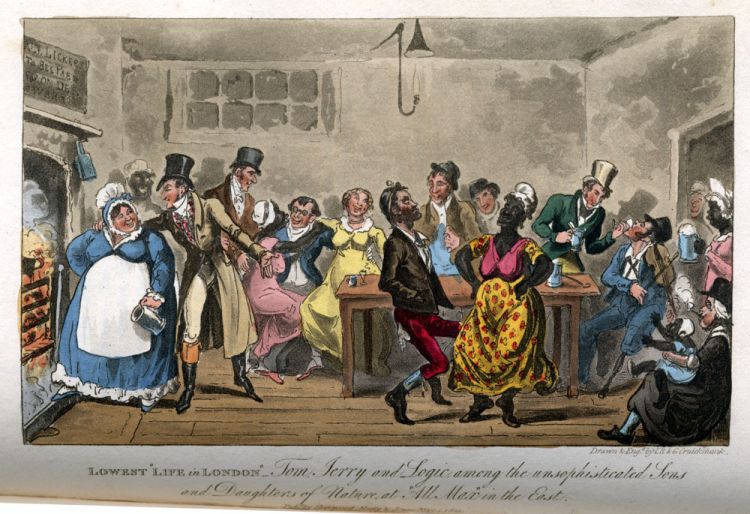
Fig. 14 Robert and George Cruikshank, “LOWEST “LIFE IN LONDON.” Tom, Jerry and Logic among the unsophisticated Son and Daughters of Nature, at “All Max” in the East,” Life in London; or, the Day and Night Scenes of Jerry Hawthorn, Esq., and his Elegant Friend Corinthian Tom, Accompanied by Bob Logic, the Oxonian, in their Rambles and Sprees through the Metropolis (London, 1820-21). Courtesy of The Ohio State University Rare Books and Manuscripts Library.
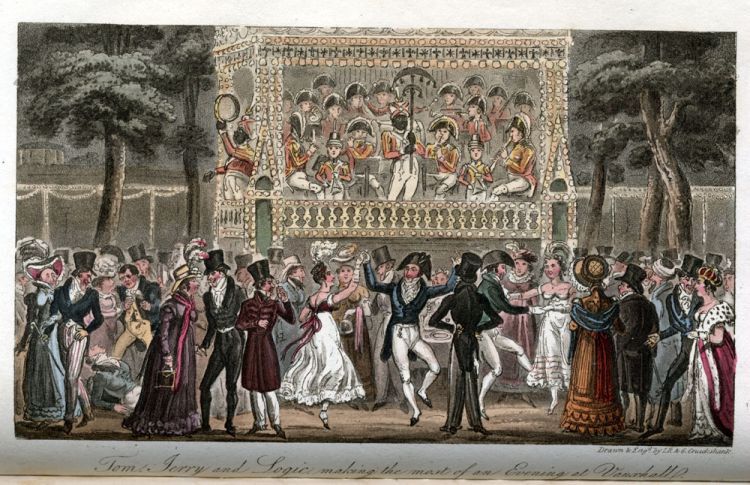
Fig. 15 Robert and George Cruikshank, “Tom, Jerry and Logic making the most of an Evening at Vauxhall” , Life in London; or, the Day and Night Scenes of Jerry Hawthorn, Esq., and his Elegant Friend Corinthian Tom, Accompanied by Bob Logic, the Oxonian, in their Rambles and Sprees through the Metropolis (London, 1820-21). Courtesy of The Ohio State University Rare Books and Manuscripts Library.
Similarly, in the scene at All-Max (an East End dive whose nickname puns on “max,” a slang term for gin, and “Almack’s,” the exclusive West End assembly rooms) (see figure 14), the text for Part Nine concludes before we can learn what will come of Logic’s dalliance with the local women. Inquiring minds had either to wait a month to discover what Logic was doing in “the ‘Fields of Temptation,’ by which he was surrounded” (289)—and even then he coyly avoids the questioning of his friends as to specifics—or else they had to set out for Wapping in the hope of a reenactment. The reverse situation obtains in Part Eleven when our heroes visit Vauxhall where, Logic tells Jerry, “if enjoyment is your motto, you may make the most of an evening ... more than at any other place in the Metropolis” (335). Yet after the trio has listened to music, admired the paintings, had a bite to eat, “join[ed] the merry dance,” and watched Logic knock down a dandy with a single blow, Bob “reeled off” and “as upon former occasions, was not to be found” (338), though Tom suspected that he had “los[t]” his “way in the dark walks” frequented by prostitutes (339). None of this, however, was represented in any of the plates in that part. Would-be viewers of the scene had wait for the final installment (two weeks later) (figure 15) or else see whether their own attempts to “enjoy ... themselves to the utmost extent in all the variety” the Gardens “afforded” (338) could shed sufficient light on the Oxonian’s fate.
The one significant departure of the post-tipping point parts and, of course, of the subsequent single-volume editions which allowed for a more varied temporality of reading—including the skimming and skipping studied by Leah Price—is the way in which they build in Jerry as a sort of proxy for the readers and viewers of Life in London. Like them, Jerry is learning to “see Life” under the tutelage of Tom and Logic and so his progress is implicitly positioned as somehow parallel to their own. As “he bid fair ... to become as prime an article” as his tutors “in being at home to ‘a peg’ in all their various SPREES and RAMBLES” (171), so too, the suggestion seems to go, could Egan and the Cruikshanks’ readers acquire a universal comfort.
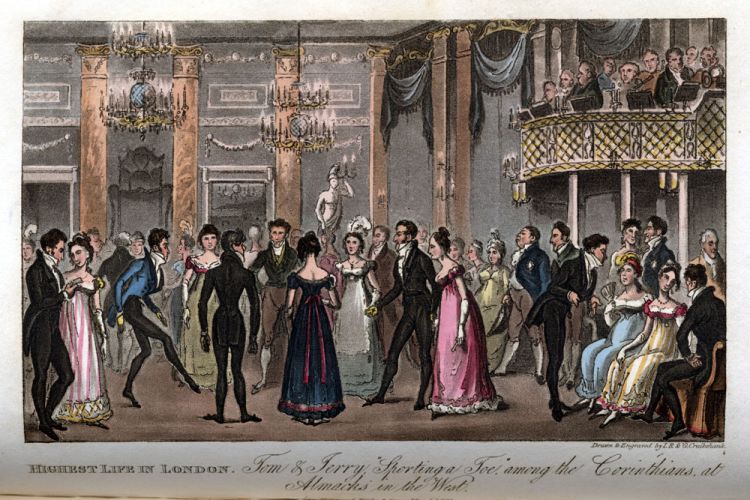
Fig. 16 Robert and George Cruikshank, “HIGHEST LIFE IN LONDON. Tom & Jerry “Sporting a Toe,” among the Corinthians, at Almacks in the West,” Life in London; or, the Day and Night Scenes of Jerry Hawthorn, Esq., and his Elegant Friend Corinthian Tom, Accompanied by Bob Logic, the Oxonian, in their Rambles and Sprees through the Metropolis (London, 1820-21). Courtesy of The Ohio State University Rare Books and Manuscripts Library.
Similarly, if Jerry can learn to appreciate how moving “from ALL-MAX in the East to ALMACKS in the West” (see again figure 14 and figure 16) is “almost like the rapid succession of scenes in a play, which will tend highly to increase the effect” and make “the contrast ... delightful,” then surely the “fire-side heroes and sprightly maidens” watching over his shoulder could relish similarly “good opportunit[ies] for observation” (291), even if they couldn’t gain admission to either place. But, of course, the adequacy of these representations and so of Jerry’s abilities to serve as our proxy are always half in question. A scant two-thirds of the way in, he confesses that he has “heard talk of the varieties of ‘LIFE IN LONDON,’ but what I have already seen beggars any thing like attempt at description” (227).
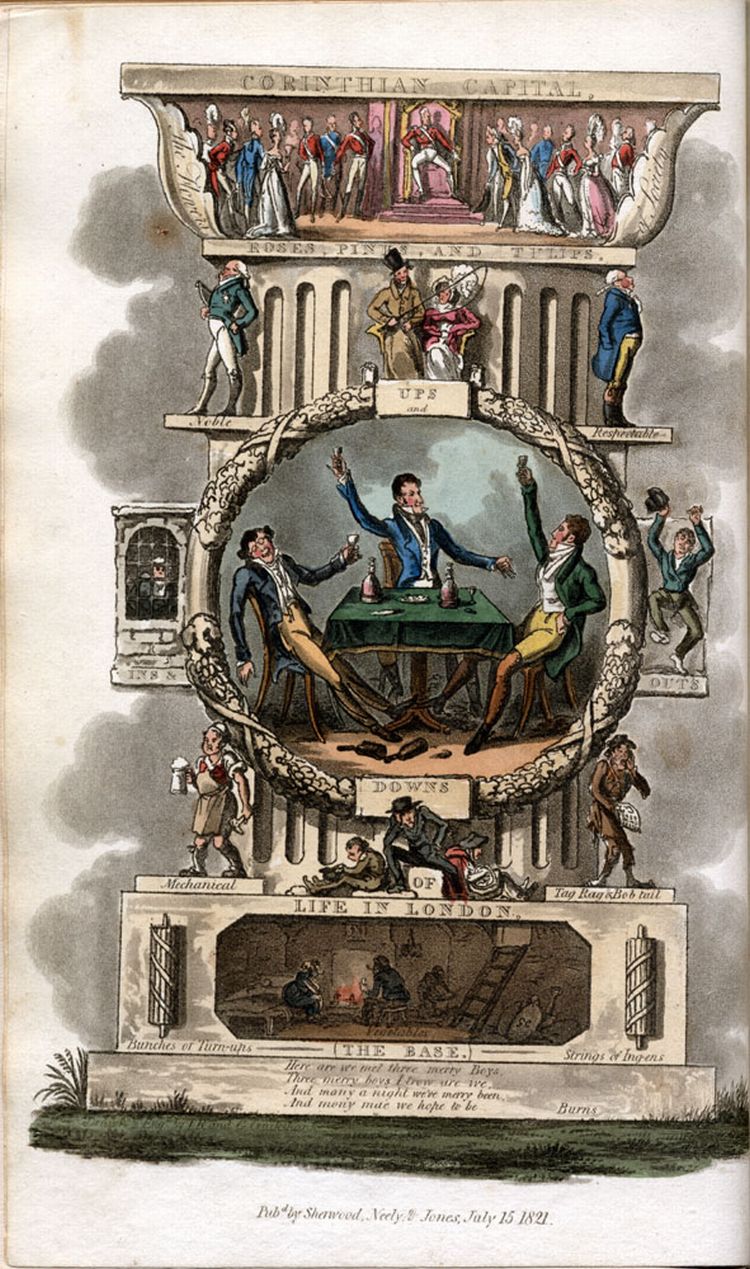
Fig. 17 Robert and George Cruikshank, Frontispiece to Life in London; or, the Day and Night Scenes of Jerry Hawthorn, Esq., and his Elegant Friend Corinthian Tom, Accompanied by Bob Logic, the Oxonian, in their Rambles and Sprees through the Metropolis (London, 1820-21). Courtesy of The Ohio State University Rare Books and Manuscripts Library.
And yet by the close, he has taken his place with his friends at the very center of not only the frontispiece (figure 17), but, it would seem, the “UPS” and “DOWNS” and “INS” and “OUTS” of life in London more generally, the whole structure of which apparently relies upon not “a shade” being “forgotten in the portraiture” (xiv).
While as a book Life in London was enough of a sensation for its publishers to have allegedly “netted some thousands by it” by 11 March 1822, what turned the phenomenon all the way up to eleven and helped ensure its place in the collective memory of Thackeray’s generation were the assorted theatrical versions, the most successful of which—>W. T. Moncrieff’s Tom and Jerry—supposedly earned “the proprietors of the Adelphi theatre,” where it was staged, twelve thousand pounds by that same point in the spring of 1822 (“London Chit-Chat” 333, 334). Indeed, Moncrieff later estimated that they “cleared” “not ... less, from first to last, than Twenty five Thousand Pounds by it” (Moncrieff 1828, vii).
Like the post-tipping point parts of Life in London, the various plays are all devoted to working out the aesthetics of “seeing Life” and its accompanying questions of representational adequacy. Accordingly, I’d like to suggest, the theatrical versions can help test and confirm the ways in which the forms we’re dealing with were “social” and so are of explanatory value when we’re trying to figure out what drove this craze. Before I sketch out the workings of the most prominent of these plays, however, it’s worth noting that they were all staged at the so-called “illegitimate” or minor theaters, the status and characteristics of which amplified a number of aspects of their form. First of all, for many playgoers, the illegitimate theaters were on the side of liberty and fun and modernity, against the perceived stodginess and perhaps worse of the patent theaters, which “had come to be identified as the cultural synecdoche of a corrupt political state” (Moody 74). Part of that reputation stemmed from the shameless, Polonius-like generic mixture of the plays which they staged (in order to get around the legal prohibition on the minor theaters offering “legitimate”—i.e., primarily spoken—drama, they would add all sorts of spectacle and music to their productions). As evidence of just how far these mixtures could go, consider only the playbills for three of the most popular theatrical versions of Life in London: at Davis’s Royal Amphitheatre, one could take in “an entirely New, Whimsical, Local, Melo-Dramatic, Pantomimical Equestrian Drama,” while Sadler’s Wells offered a “New Pedestrian, Equestrian, and Operatic Extravaganza ... of Gaiety, Frisk, Lark, and Patter” and Moncrieff’s version at the Adelphi was billed as “an entirely new Classic, Comic, Operatic, Didactic, Aristophanic, Localic, Analytic, Panoramic, Camera-Obscura-ic, Extravaganza Burletta of Fun, Frolic, Fashion, and Flash ... Replete with prime Chaunts, rum Glees, and Kiddy Catches” (qtd. in Hindley 4, 85, 8). Another part of the reputation of the minor theaters derived from the sheer “visual magnificence” (Moody 151) of the playhouses themselves, which was often at odds with their somewhat dodgy or unfashionable locations.
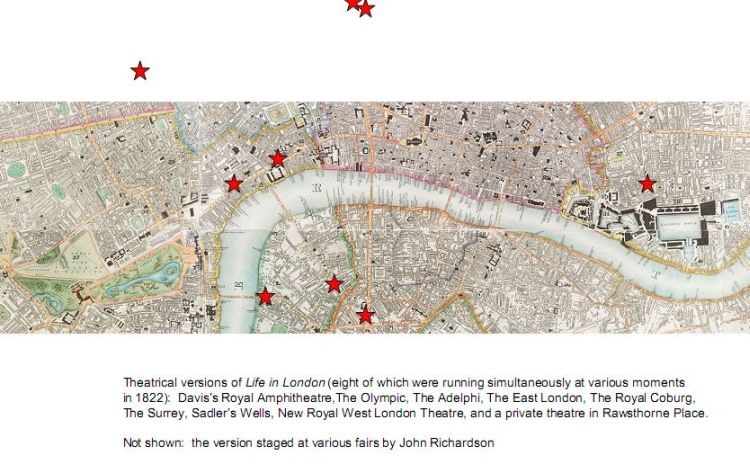
Fig. 18
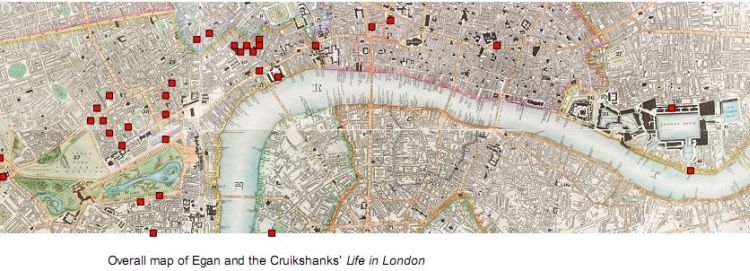
Fig. 19
Compare, for example, where the various versions of Life in London were staged with where the action of the Cruikshank plates was located. (see figure 18 and figure 19) Close to half of the scenes depicted in Life in London (many of which transferred over to the plays) were set in the West End, while nothing other than our heroes’ outing to Vauxhall involved crossing the Thames. Yet three of the theaters were on the south side of the river and another three were out on the north edge of town (far beyond anywhere Tom and Jerry bother to go). Only the Olympic, the Adelphi, and (as a somewhat special case) the East London were actually in the same neighborhoods as the “rambles and sprees” they were representing. Yet all of their buildings were every bit as opulent, if not more, than the patent theaters of Covent Garden and Drury Lane where Tom and Jerry were shown consorting with prostitutes and actresses showing their legs. Collectively, I’d like to suggest, these different aspects of the “illegitimate” theaters’ reputation helped to further crank up the aesthetics of “seeing Life” by linking that pursuit to the pleasurable disjunctions of minor theatergoing more generally. That is, the questions of representational adequacy which the plays took up from Egan and the Cruikshanks became, if anything, all the more pointed when posed in a setting so clearly devoted to (and renowned for) dramatizing the mimetic gap between life on stage—where people burst into song, cross-dressed, and rode horses indoors—and the more quotidian existence outside the theater, with the pleasure-seeking audience in an opulent and liminal space between the two.
The first of the theatrical versions of Life in London nicely exemplifies the uses to which this gap could be put. On 17 September 1821, William Barrymore’s Tom and Jerry, or, Life in London debuted at Davis’s Royal Amphitheatre (better known to most theater historians as Astley’s) and was their chief offering for at least the next three seasons. As its subtitle suggests, this play took the “popular Production, which has lately engrossed the attention of all London” and turned it into “an entirely new Whimsical, Local, Melo-Dramatic, Pantomimical Equestrian Drama.” There’s nothing all that surprising about such a transformation: equestrian shows were the specialty of the house and so audiences were treated to a “scene of Epsom Races” which “exhibits post-chaises, gigs, tilburys, caravans, hackney-coaches, carts, and four-in-hand barouches, all drawn by real horses ... concluding with a grand race between seven ‘Bits of Blood!’ on extensive platforms taking the whole width” of the theater (The Drama 2: 360).
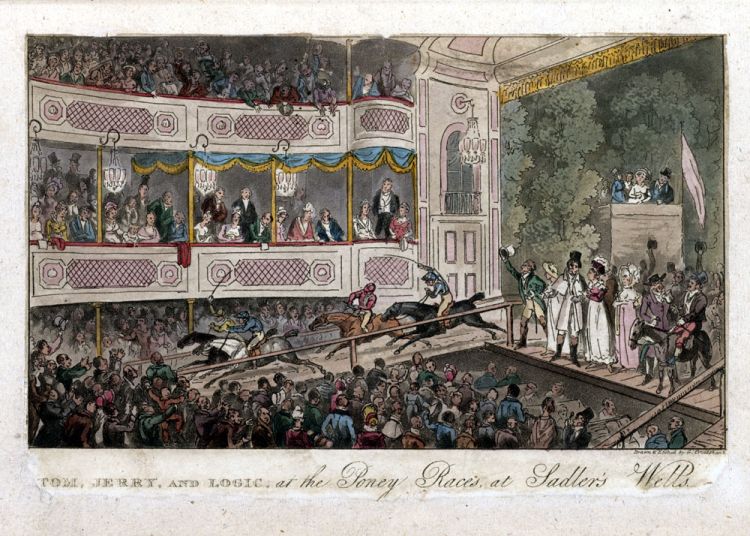
Fig. 20 George Cruikshank, “TOM, JERRY, AND LOGIC, at the Poney Races, at Sadler’s Wells” (London, n.d. [c. 1822]). Bound into a copy (*EC8 C8885 820e) of Life in London; or, the Day and Night Scenes of Jerry Hawthorn, Esq., and his Elegant Friend Corinthian Tom, Accompanied by Bob Logic, the Oxonian, in their Rambles and Sprees through the Metropolis (London, 1820-21). Courtesy of the Houghton Library, Harvard University.
For a similar scene from Egan’s own theatrical version at Sadler’s Wells, which nicely brings out the sheer oddity of the spectacle, see figure twenty. More tellingly for our purposes, however, the usual sporting or martial or orientalist fare for which Davis’s was known here gets offset by some decidedly metropolitan scenes. For example, there’s what the reviewer just quoted describes as “the exterior of the Opera House, with all the horrors of a rainy night,” which involves Kate and Sue being cheated by one hackney cab driver as they depart for Almack’s and Tom, Jerry, and Logic playing a prank on another (they get in, tell him where they’re going, and get out the other door), as rain begins to fall on stage. Similarly, the scenes in Jackson’s Rooms and Cribb’s Parlour not only had “the Clown prove ... himself a ‘hard hitter,’ by sending Harlequin clean through the wainscot,” but also offered live performances by “Cribb and Spring,” “stripped half naked, boxing each other round the platform” to the supposed offense of “female modesty” (The Drama 4: 306). Such spectacles were, of course, readily witnessed in the metropolis, as were “views of Tattersal’s... and Temple Bar, by moonlight” (The Drama 1: 306). But they were witnessed across the river in rather different parts of town and, for the most part, not by the “genteel people, with their children and servants” who “had long ... frequented” this theater (Moody 171).

Fig. 21
Literally, then, there was a significant spatial divide between the space of seeing and the space of the seen (see figure 21). Audience members were the Westminster or Waterloo bridge away from any of the action being represented. Yet that divide was repeatedly and spectacularly “bridged” by the sight of these different parts of London right there on stage in all their equestrian or pugilistic or simply drenched glory. The result, I’d like to suggest, was a highlighting of the same sort of simultaneous adequacy and inadequacy of representation that we’ve been tracing in Egan and the Cruikshanks. On one hand, what’s on stage is clearly not “Life” of the sort one is supposed to be seeing: the “street row” Tom and Jerry get into after boxing a charley poses absolutely no danger to any of the spectators. Yet on the other hand, there are actual coaches on stage, a “half naked” Cribb is boxing around, and the handsomely dressed dancers in the scene at Almack’s do a quadrille, lancers, and “2 Cast Figures” (28). How much closer to “Life” can one get? And once again this doubleness is encapsulated in the talismanic phrase of the title: when at the close Logic sings “then masquerade it now away, we ne’er shall wish the fun done, / That is, should you be pleased to say, you like our Life in London” (40), does that refer simply to what the audience has just witnessed or more broadly to what the play supposedly stands in for? Either way, it was enough to induce “Mr. Astley to keep his theatre open near a fortnight later than his usual period of closing” and to yield three hundred eighty pounds for Barrymore at his first benefit (“thirty pounds more than upon any previous occasion”), but I suspect that that success stemmed in no small part from how “that reality which ... attach[es] itself to the scenes and incidents” came off as delightfully partial: both mimetic and quite ostentatiously in violation of mimesis.
A rather different configuration of these same elements seems to have driven the next theatrical version to be offered: Charles Dibdin’s Life in London; or, the Larks of Logic, Tom, and Jerry, An Extravaganza ... Founded on Pierce Egan’s Highly Popular Work, which opened at the Olympic Theatre on 12 November 1821 and ran one hundred ninety-one nights. Here, rather than keeping a clear, if bridgeable distance between the theater and the putative location of the action on stage, the play repeatedly threatens to collapse the two. This is particularly evident in a scene set in an unspecified, but Olympic-like theater in which Tom and Jerry check out a “pretty girl” so “new” that even Tom doesn’t “know her” and then briefly debate the ethics of “intrud[ing] upon the Engagement of another gentleman” (i.e., soliciting a prostitute already with a client).
The girl’s accomplices then pick a fight with our heroes and Jerry plunges in: “Oh, there’s a row! I must be in that, because it’s Life in London” (11). As we know from the plate of “Tom & Jerry in the Saloon at Covent Garden” (see again (figure 4), prostitutes routinely worked the lobbies and boxes of the theaters, and pickpockets and conmen would regularly instigate “rows” in order to gain an advantage over their marks. So it might seem as if Dibdin’s play is operating uncomfortably close to home, putting on stage what was probably already being more casually performed in and around the theater.
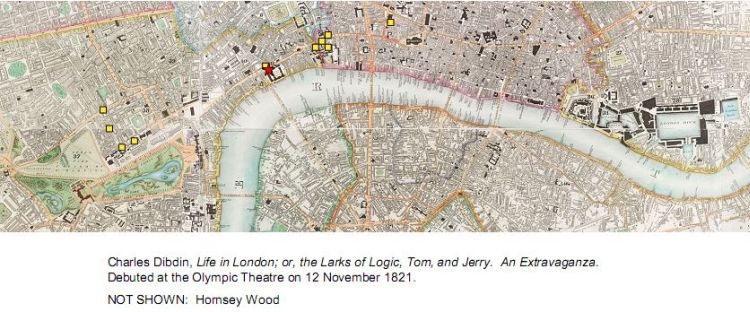
Fig. 22
And the rest of the geography of the play could support such an impression: the majority of the action and all of the “larks” are set within a five minute walk of the theater, in and around Temple Bar (see figure 22). One can easily imagine that there were some post-theater attempts to steal a charley’s box or to crash a cockney party (as Tom, Jerry, and Logic do). But as with our other texts, that implicit invitation to compare the “Life” on stage with that surrounding it is counterbalanced by various moments which call attention to the patent theatricality (and so presumed difference) of what the actors were doing. Hence the brawl in the lobby turns into a song whose chorus is “sure never row was so monstrously uproarious, / This is Life in London, how d’ye like the go?” (13). Similarly, the chorus of the finale asks the audience “your plaudits of patronage kindly then give, / And let Life in London, in London, long live; / For features of fancy howe’er we pursue, / No fancy’s true fancy not fancied by you” (40). As with Barrymore’s version, this begs the question of what it would mean to “let Life in London, in London, long live.” Simply return frequently to the Olympic for more of this “extravaganza of fun, frolic, and whim” (The Drama 2: 51)? Routinely engage in actual rows? And what would happen if a real-life counterpart to Jerry presumed that a member of “the fancy” wasn’t “true fancy” since he didn’t accord with his own “fancy”? Would he be able to conclude with the stage Jerry that “Life in London’s nothing without adventures” (29)? Again, either way, the play clearly worked and was “repeated every evening to overflowing audiences of the most fashionable description” (The Drama 2: 206), despite, or perhaps because of, what Jane Moody terms the theater’s rather “insalubrious location” (31)—remember only the midnight scene at a nearby coffee shop (see again figure 12).
But the reason why it worked, why “‘Tom, Jerry, and Logic’ still delight with their whimsical ‘sprees and larks’ ” (The Drama 2: 253), has, I’m proposing, a great deal to do with the way in which that whimsy simultaneously promoted and undermined the project of “seeing Life” in the area surrounding the Olympic.
The third theatrical version to be staged, that by Moncrieff, which debuted at the Adelphi on 26 November 1821, offered yet another arrangement of the devices through which these questions of representational adequacy could be posed.
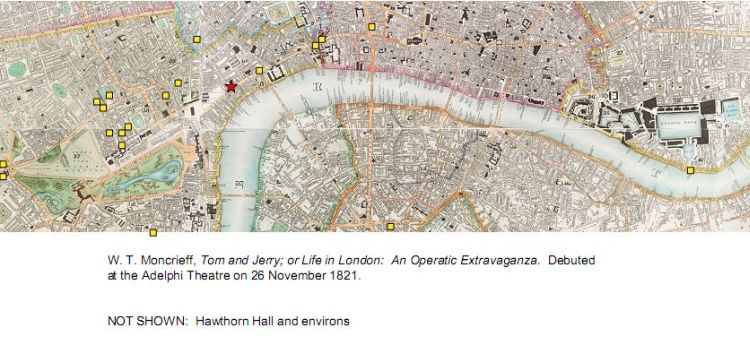
Fig. 23
Rather than opening up or dramatically collapsing the gap between the space of the seer and the seen (as Barrymore and Dibdin had done), Moncrieff largely replicated the spatial distribution of Egan and the Cruikshanks’ Life in London (see figure 23 and figure 19 again) There were fewer sites, of course, because of time constraints and the demands of staging, but with two intriguing exceptions, Moncrieff’s version offers the same basic array of activities in most of the same places (although for some reason he relocates Kate and Sue’s visit to a fortuneteller from St. Giles to St. George’s Fields). The two exceptions, though, are extremely revealing. First, Moncrieff omits the spaces associated with prostitution by Egan and the Cruikshanks: Kate’s apartment and the theaters. Secondly, he cuts out or relocates all the opportunities for sprees and their consequences near Covent Garden (the coffee and gin shops and Bow Street simply disappear; the watchhouse gets moved east of Temple Bar), so that such activities now take place in distinctly different neighborhoods than that of the theater. One could try to account for these cuts by suggesting that they’re an attempt to raise the moral tone of Life in London or to provide a cordon sanitaire between the space of viewing and the viewed. But then it would be rather difficult to explain why Moncrieff invents a plot in which Kate and Sue (who are no longer cyprians, but simply the sweethearts of Tom and Jerry) follow their loves all over London, posing as dancers at Almack’s, gamblers in a “fashionable hell,” beggars in the Holy Land of St. Giles, and perhaps most discordantly of all, if the aim was to clean up Life in London, “two young bucks” who accost the wife of a cit and kiss her—lest anyone miss the point, Logic leeringly observes a minute or two later how “very well” the object of their affection “must look in” breeches like the ones being worn by Kate and Sue ( Moncrieff 1828, 37, 43). Similarly, any theory along the cordon sanitaire lines would rapidly run afoul of what was apparently one of the real attractions of the Adelphi’s production: namely, its portrayal of actual street celebrities like Andrew “Little Jemmy” Whiston, a paraplegic beggar who propelled himself about in a little cart, or Billy Waters, the one-legged African fiddler and “King of the Beggars.” What sense would it make to bring such figures on stage if the aim was to keep the “low” at bay?
Moncrieff’s cuts become significantly more comprehensible, though, if we consider them in conjunction with the very Egan-like claims of the Adelphi’s early advertising. According to one playbill, this was “an animated picture of every species of Life in London, deprived, through the filtering stone of the Proprietor’s critical care, of all that might disgust or offend even the most fastidious Imagination.” Yet less than twelve weeks later, the play was being offered as “a series of pungent and minutely accurate Representations of HIGH and LOW LIFE.”
Similarly, the whole piece was a ballad opera, with new words to familiar tunes and so was likely to conjure up a quite complicated array of memories of previous theatergoing (to The Beggar’s Opera, to The Benevolent Tar, to Don Giovanni), even as it featured “Twenty New Scenes, Painted from Drawings taken on the spot” and “the Publishers of the various Maps and Guides through London” were rather cheekily, if “respectfully informed, that this Piece does not supersede the Necessity of their various Publications” as they “may still be useful in refreshing the Memory of the Spectators, after the Conclusion of the Adelphi season” (Moncrieff, Songs tp, v).
So, it would seem that, as with Life in London itself, Tom and Jerry is somehow both filtered and minutely accurate, representationally inadequate and yet up to the task. Unlike Egan and the Cruikshanks’ version, however, Moncrieff’s play drew a quite socially—and therefore geographically—varied audience: dukes and dustmen, peers and apprentices, the first member of the royal family ever to visit a minor theater (Frederick, Duke of York) and “the people” whose “appearance” made Harriet Arbuthnot turn up her nose. Indeed, in the closing address to the 1821-22 season, the actor who played Tom called explicit attention to the “overflowing audiences” the Adelphi had attracted, “comprising a galaxy of the brightest stars of the West, and a maximum of the primest natives of the East” (qtd. in The Drama 2: 311). What’s missing in all this socio-geographic language, of course, is the middle, both of the social order—there are apparently no counterparts in the audience to Jemmy Green, the cockney dandy of the play—and of the metropolis itself. This absence, I think, helps reveal the significance of Moncrieff’s geography. Put simply, Covent Garden has been emptied out (except for a few sporting destinations like Cribb’s Parlour, which gets replicated on stage with the exhibition of the champion’s “ORIGINAL CUP” [Moncrieff, Songs iv]) in order to make all these questions of representational adequacy depend upon the origins of the audience, rather than on the location of the theater. That is, by preserving Egan and the Cruikshanks’ spatial distribution (except for the area around the Adelphi) and then soliciting, incredibly successfully, an audience from both West and East, Moncrieff was able to transfer the felt site of viewing from the playhouse in the Strand to wherever the individual audience members came from. Accordingly, “the scene of ‘All Max in the East,’ is well worth seeing by any one who does not mind contemplating filth, and profligacy, and vagabond merriment. The man who performs ‘Dusty Bob’ makes a wonderful fac-simile of a squalid ‘coster-monger,’ a being made up of gin, rags, occasional starvation, and perpetual knavery” (“London Chit-Chat” 334)(see figure 24).
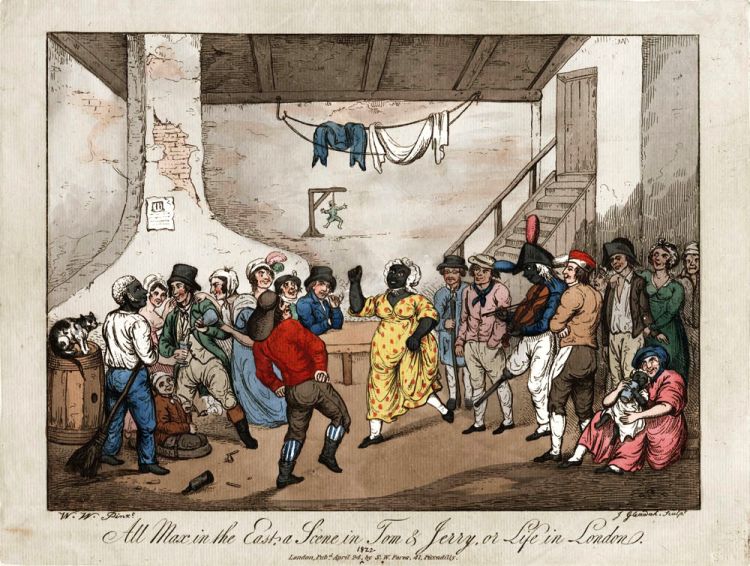
Fig. 24 W. W., “All Max in the East, a Scene in Tom & Jerry, or Life in London” (London, 1822). Courtesy of the Lewis Walpole Library, Yale University.
Conversely, “the outline of fashionable life discovers more than is frequently known of London, by those who are its residents from the cradle to the tomb” (“Advertisement”). In each of these passages there’s a clear sense of what is known and what is unknown and so where the play’s representational adequacy can or cannot be easily confirmed. But, of course, the areas which are known are quite different: the writer for Blackwood’s seems to presume that filth and squalor are unusual sights for its readers, while the author of the “Advertisement” in the Albany edition of Moncrieff has apparently never set foot in Almack’s or Burlington Arcade. The different vantage points that these writers exemplify, however, were brought nightly into extremely close contact with one another: “upwards of one hundred nights” into the first season it was “yet an affair of peril to squeeze your way into the pit” (“London Chit-Chat” 333) and the theater was still “collect[ing] overflowing audiences” two seasons later (The Drama 5: 247). Such unavoidable proximity seems like it would almost have to have produced a doubleness of perspective not wholly unlike that of Mrs. Arbuthnot: something like “if I can assess the adequacy of this, but not that, and, judging by his appearance, he can assess the adequacy of that, but not this, and yet here we all are jammed together in ‘a very pretty theatre’ whose surroundings constitute a common ground that is pointedly not being represented on stage, then perhaps the thing to do is simply to ‘attend’ Tom and Jerry’s ‘larks and rambles,’ to ‘witness [their] sprees, and encourage [their] endeavours’ without worrying overmuch about ‘the fidelity of its representation of London manners’.”
If so, then it makes sense that the most “laughable” scenes—“the night row at Temple-bar, and ... the meeting of all the celebrated beggars and ballad singers of the metropolis” (The Drama 2: 207)—were precisely those which most clearly raised the issue of adequacy, only to immediately suspend it: Temple Bar was close enough for all to verify, while the inner recesses of the Holy Land were inaccessible to almost everyone.
Accordingly, one could either sit back and enjoy what the Times termed the play’s “ludicrous and tolerably faithful pictures” of “the characters and customs of the different classes of society” into “which the irregular habits” of Tom, Jerry, Logic, Kate, and Sue’s lives threw them or else one could set out on “nocturnal ‘sprees’ ” of one’s own and it seems telling that the most popular sort of spree—“milling the Charlies”—was precisely that which was least place-specific and so most equally available to all: there were charleys, and reports of pranks against them, all over town ( “London Chit-Chat” 334).
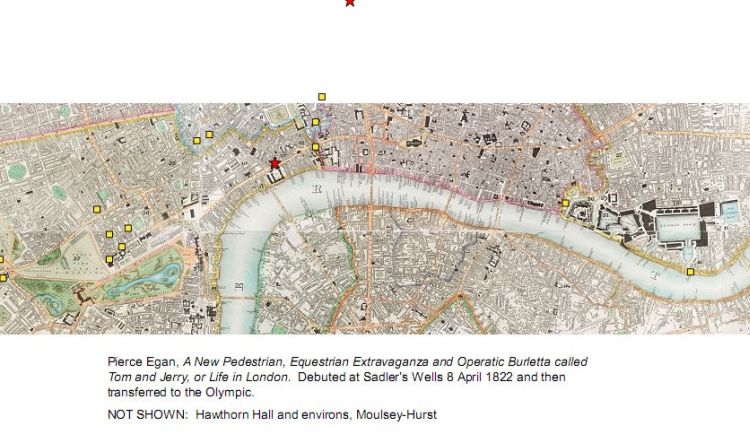
Fig. 25
We could go on in this vein and think, for example, about why Egan’s own theatrical version, initially staged at Sadler’s Wells on 8 April 1822 and then transferred to the Olympic for a hundred and ninety-one night run, should have stripped out so much of the Covent Garden slumming and West End blood sports, only to turn around and close with an apparently unmotivated pony race at the “pugilistic Waterloo” of Moulsey Hurst in the far western suburbs (see figure 25 and figure 20 again). But I suspect my broader point has been made. Each of the plays offers a form through which its audiences could indulge in the representational uncertainties of “seeing Life,” but each does so differently, which no doubt fostered comparisons between the versions, particularly in the spring and summer of 1822 when there were so many simultaneous productions underway. A writer for John Bull imagines that the latter was simply a shrewd commercial move: “that which appears a silly opposition in producing the same piece at all these houses, will eventually turn out capitally; for now, instead of being contented with seeing one TOM and JERRY, the town will not be satisfied till they have seen them all; and as the last three months were spent in discussing the merits of the first, so the whole summer will be devoted to comparing notes, and qualifying for ‘Critic,’ upon the new editions of this very extraordinary performance” (14 April 1822). But such comparison would almost have to have redoubled and thereby rendered all the more tantalizing and delicious all the various questions of representational adequacy that each play had pursued individually. This, I’d like to suggest, offers a rare glimpse into just how “profoundly social” form can be: it’s not only that the forms of individual texts are shaped by forces both beyond their bounds and beyond their control, but also that the significance of those individual forms largely emerges from their perceived relations with one another.
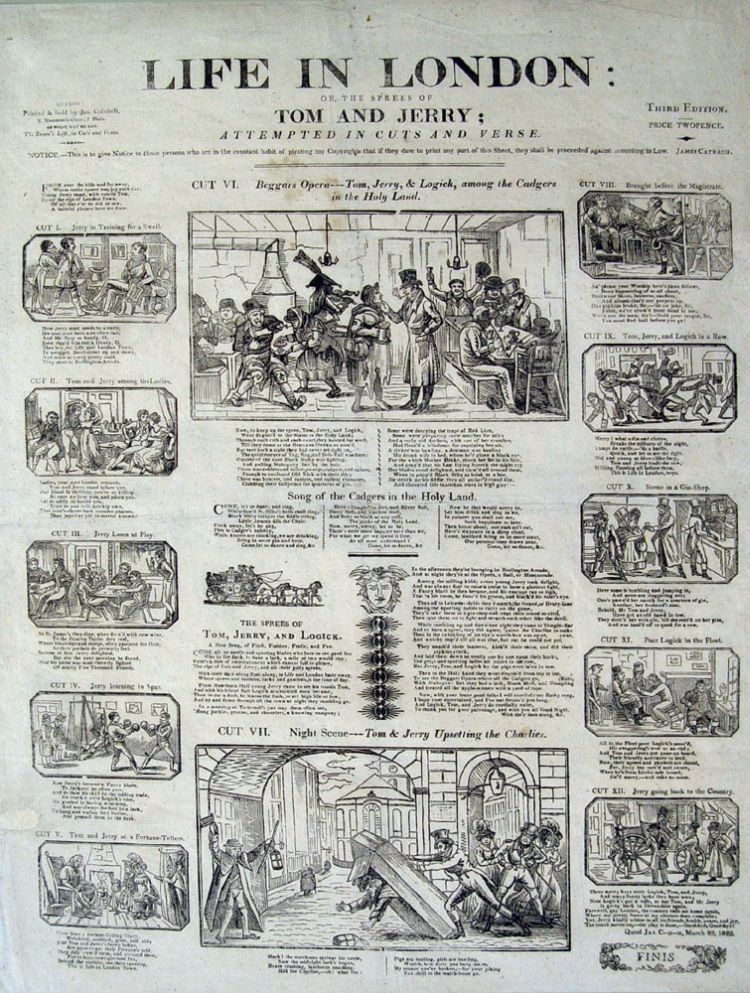
Fig. 26 "LIFE IN LONDON: OR, THE SPREES OF TOM AND JERRY; ATTEMPTED IN CUTS IN VERSE” (London, n.d. [c. 1822-23]). Courtesy of The Trustees of the British Museum.
The pleasure one can take in, say, the Adelphi’s version of “seeing Life” is thus in no small part shaped by the pleasure one has taken—or hopes to take or has heard or imagined others have taken—in Davis’s version or the Olympic’s version or Sadler’s Wells’ version or any of the other versions on offer, including, of course, that of Egan and the Cruikshanks or the dramatically downmarket redaction offered by Catnach (see figure 26). Moreover, one doesn't need to have actually seen or read those other versions in order for them to have shaped the felt significance of the text at hand; one simply needs to have known of their existence, and in a craze like that for Life in London, it would have been hard to remain ignorant, when even the very ballad singers on the streets were reminding passers-by that “And since Life in London / Has been all the rage, / There’s nothing else now / That will do for the stage” (qtd. in Hindley 120).
The question that this all begs, of course, is why should Life in London have so taken off when it did, only to then become so retrospectively puzzling as Thackeray’s generation moved into adulthood, given that most of its different components had long been and would continue to be available? Pugilism and other blood sports, “the city representing itself to itself” (During 342), young men from the West End going into Covent Garden or beyond on nighttime “sprees” ... these had all been a part of metropolitan life for decades or even centuries and didn’t magically disappear with the coming of the railways.
What was different in the early 1820s, though, was the status and reputation of London itself. As James Chandler has reminded us, the years leading up to and surrounding the mania for Life in London operated according to a particularly “hot chronology,” their “peculiar eventfulness” making it seem as if things were changing almost day by day (3). In 1819 and the first half of 1820, both the metropolis and the nation more generally seemed poised on the brink of revolution: mass meetings of unprecedented size gathered in almost every town and sometimes, as at “Peterloo,” were met with savage violence on the part of the authorities; the Six Acts rendered the exercise of quite basic traditional rights treasonous; radicals in Cato Street plotted to assassinate the Cabinet and the Prime Minister; Lady Jerningham thought “the Queen’s bold return to England,” despite her husband’s open animosity, had moved the “country ... nearer disaster than it has been since the days of Charles I” (168), as crowds flooded the streets in open defiance of the soon to be crowned George IV. And yet by the time that the first few parts of Life in London were appearing, that had all melted away: Caroline was acquitted in mid-November (or rather, the divorce case against her was abandoned) to widespread rejoicing, “the anger that had sustained ... radical action ... in the regency years virtually evaporated” (Gatrell 420), it was as if the end of the year belonged to a different “epoch” than its beginning.
And this transformation was at its most dramatic in London itself. From the dangerous moment when “tens of thousands” of onlookers “booed and hissed” when the executioner held up the “severed heads” of the Cato Street plotters (Laqueur 423) to November 1820, when The European Magazine could approvingly pronounce that Egan’s subject was “the world’s epitome; London!” (rev. of Life in London 436), was, calendrically, only six months, but phenomenologically and emotionally the two points were worlds apart.
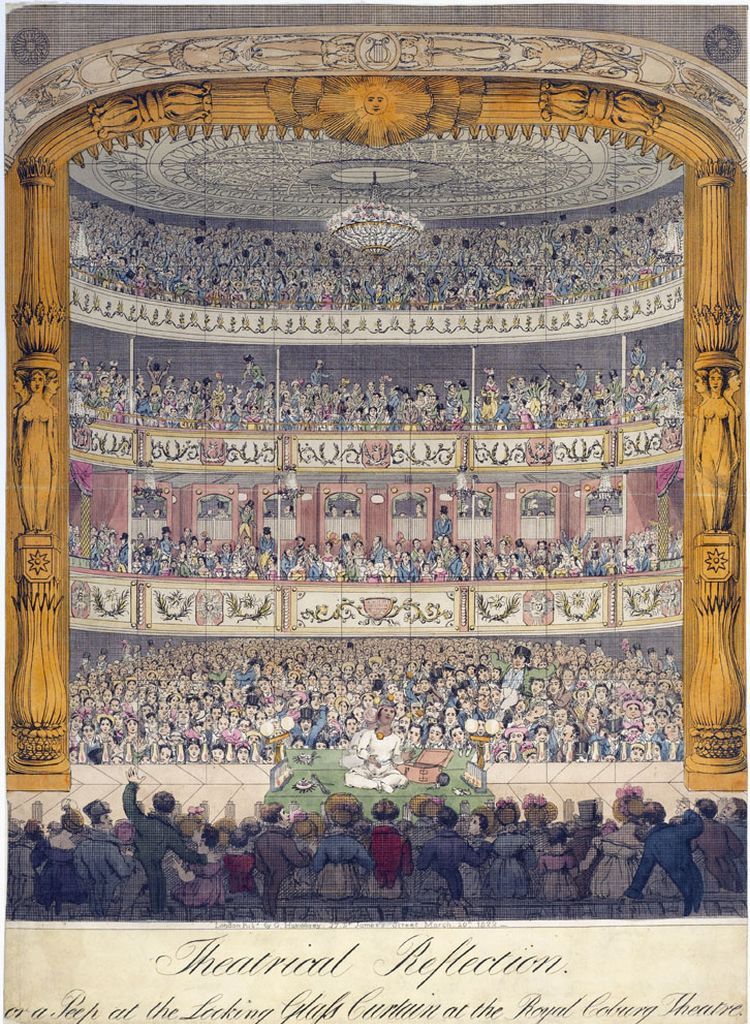
Fig. 27 Theatrical Reflection. or a Peep at the Looking Glass Curtain at the Royal Coburg Theatre” (London, 1822). Courtesy of the City of London, Metropolitan Archives.
Perhaps the single best emblem of this change was the so-called “Looking Glass Curtain” which debuted at the Royal Coburg Theatre on 26 December 1820 (see figure 27). As its name would suggest, this was a huge mirror (or rather, sixty-three mirrors set together in a giant frame), which “reflected every form and face in that gorgeous house, from the topmost seat in the galleries, to the lowest bench in the pit” (Fitzball v-vi) and which was in itself apparently enough both to “fill all the places” and to arouse the envy of the other minor theaters (Dibdin 20).
The sheer attitudinal shift necessary for the Royal Coburg’s venture to have been a success, the newfound capacity to take pleasure in seeing oneself as part of a socially varied tableau vivant, when only a year previous the denizens of the galleries were thought to be preparing themselves to slaughter many of the habitués of the pit ... this marks the advent of a quite astonishing metropolitan self-regard and one to which much of the rest of the Anglophone world twas apparently willing to accede. A writer in upstate New York, for example, thought that Moncrieff’s play would “convince the ear and the eye that London is the world in miniature, and possesses every thing from the acme of splendor to the ne plus ultra of grossierté” ( “Advertisement” ). Inevitably, however, such buoyant sentiments proved a bubble and “between 1825 and 1837 the mood of self-confidence, the devotion to urban values, and the pride in London all came to an end” (Olsen 21).
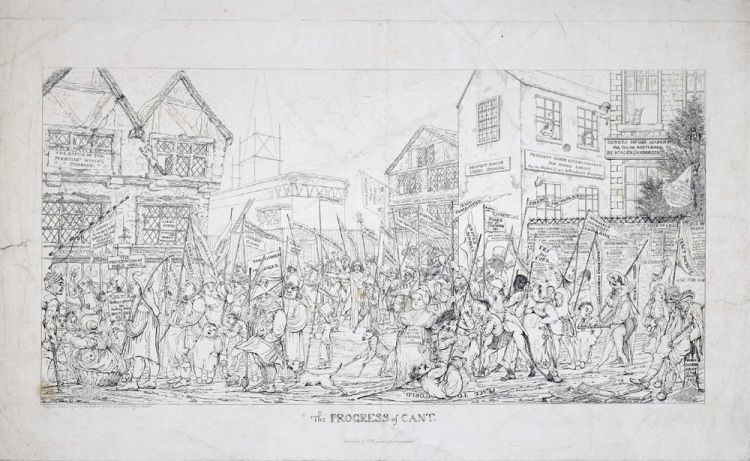
Fig. 28 "The PROGRESS of CANT” (London, [1825]). Courtesy of The Trustees of the British Museum.
Banks failed, building came to a halt, cholera arrived from the East, and perhaps most distressingly of all for the kind of “libidinal vitality” (During 344) that drove the mania for Life in London, “low life” was recast as “a terrain of anxiety and didactic moralization: in short, it became less and less funny” (Gatrell 547). What one 1825 engraver protested as The Progress of Cant, which features at its very center a funeral mute holding up a banner reading “No Life in London” (see figure 28), rapidly became an unstemmable tide. Indeed, by the end of the decade, Egan had himself turned against his creations, killing off Tom, Logic, and Corinthian Kate in his Finish.
“The Moment of Tom and Jerry,” I’d like to propose, was enabled by the peculiar “resonance” between the social forms we’ve been examining and this fleeting “epoch” of supreme self-regard among Londoners and their admirers. To borrow Wai Chee Dimock’s acoustic metaphor, the “signal” of these forms was amplified by the “noise” of the early 1820s and so became audible in ways that would not have been possible either before or since. The result was that as the status and reputation of London changed, so too did that of Life in London. Tom and Jerry so encapsulated their moment that, once that moment had passed, they, like the Vauxhall which had provided them such “ample pleasures,” were left to constitute, at best, the puzzling memory of “a delightful perversion of the imagination” (Thackeray, “De Juventute” 512).
Works Cited
- Tom and Jerry; or Life in London: An entirely new Whimsical, Local, Melo-Dramatic, Pantomimical Equestrian Drama, in Three Acts.... founded on a popular Production, which has lately engrossed the attention of all London, entitled Life in London, by Pierce Egan. As Performed at Davis’s Royal Amphitheatre1822. London.
- “State of German Literature” Edinburgh Review 1827. vol. 46 pp. 304-51.
- Mr. Sponge’s Sporting Tour1853. London.
- “Rev. of The Tower of London: An Historical Romance, by W. H. Ainsworth” Westminster Review 1840. vol. 34 pp. 4-60.
- “Rev. of Pictures of Life and Character, by John Leech” The Quarterly Review 1854-55. vol. 96 pp. 75-86.
- “De Juventute” Cornhill Magazine 1860. vol. 2 pp. 501-12 no. 8. Roundabout Papers
- Life in England in Aquatint and Lithography, 1770-1860: Architecture, Drawing Books, Art Collections, Magazines, Navy and Army, Panoramas, Etc. from the Library of J. R. Abbey. A Bibliographical Catalogue 1953. London: privately printed at the Curwen Press.
- “Advertisement” Tom and Jerry; or Life in London; A Burletta of Fun, Frolic, and Fashion, in Three Acts. As Performed at the London, New York, Boston, and Philadelphia Theatres; Dramatised by W. Moncrief, from the Celebrated Work of that Name, By Pierce Egan 1825. Albany. pp. 1.
- “Annus Mirabilis! or, A Parthian Glance at 1822” New Monthly Magazine1823. vol. 7 pp. 21-27.
- The Journal of Mrs. Arbuthnot, 1820-1832Bamford, Francis, Wellington, Duke of (eds.) 1950. London: Macmillan. vol. 1.
- Christian Life, Its Course, Its Hindrances, and Its Helps. Sermons, Preached Mostly in the Chapel of Rugby School 1841. London.
- New Readings in Theatre History 2003. Cambridge: Cambridge University Press.
- British Fiction, 1800-1829: A Database of Production, Circulation & Reception Center for Editorial and Intertextual Research, Cardiff University.
- Speech of the Right Hon. George Canning, at the Liverpool Dinner, Given in Celebration of his Re-Election 1820. London.
- England in 1819: The Politics of Literary Culture and the Case of Romantic Historicism 1998. Chicago: University of Chicago Press.
- The Journal, Essays, The Journey from Essex Tibble, Anne (ed.) 1980. Manchester: Carcanet New Press.
- George Cruikshank : A Catalogue Raisonné of the Work Executed During the Years 1806-1877 1924. London: Office of The Bookman’s Journal.
- “Walking the City Streets: The Urban Odyssey in Eighteenth-Century London” Journal of Urban History 1990. vol. 16 no. 2 pp. 132-74.
- “‘Flash Style’: Pierce Egan and Literary London, 1820-28” History Workshop Journal 2001. vol. 51 pp. 180-205.
- Life in London; or, the Larks of Logic, Tom, and Jerry, An Extravaganza in Three Acts, Founded on Pierce Egan’s Highly Popular Work: As Performed at the Olympic Theatre (2nd ed) 1822. London.
- “A Theory of Resonance” PMLA 1997. vol. 112 no. 5 pp. 1060-71.
- “Regency London” The Cambridge History of English Romantic Literature Chandler, James (ed.) 2009. Cambridge: Cambridge University Press. pp. 335-54.
- Life in London; or, The Day and Night Scenes of Jerry Hawthorn, Esq. and of his Elegant Friend Corinthian Tom, Accompanied by Bob Logic, the Oxonian, in their Rambles and Sprees Through the Metropolis 1820-21. London.
- Life in London; or, The Day and Night Scenes of Jerry Hawthorn, Esq. and of his Elegant Friend Corinthian Tom, Accompanied by Bob Logic, the Oxonian, in their Rambles and Sprees Through the Metropolis 2nd ed. 1821. London.
- The Songs, Parodies, &c. Introduced in the New Pedestrian, Equestrian Extravaganza and Operatic Burletta called Tom and Jerry, or Life in London 1822. London.
- Pierce Egan’s Finish to the Adventures of Tom, Jerry, and Logic in their Pursuits through Life in and out of London 1830. London.
- Life in London [1869]. London. pp. 1-26.
- Thirty-Five Years of a Dramatic Author’s Life (Vol. 1) 1859. London.
- City of Laughter: Sex and Satire in Eighteenth-Century London 2006. New York: Walker.
- The Tipping Point: How Little Things Can Make a Big Difference 2000. Boston: Little, Brown.
- Glasgow Herald 6 Dec. 1822.
- The True History of Tom and Jerry; or, The Day and Night Scenes, of Life in London from the Start to the Finish! With a Key to the Persons and Places, Together with a Vocabulary and Glossary of the Flash and Slang Terms, Occuring in the Course of the Workn.d. [c. 1890]. London.
- “Introduction to the Present Edition” pp. 1-26.
- The Jerningham Letters (1780-1843), Being Excerpts from the Correspondence and Diaries of the Honourable Lady Jerningham and of her Daughter Lady BedingfeldCastle, Egerton (ed.) 1896. London. vol. 2.
- John Bull10 Dec. 1821. pp. 414.
- John Bull14 Apr. 1822. pp. 558.
- “The Queen Caroline Affair: Politics as Art in the Reign of George IV” Journal of Modern History 1982. vol. 54 no. 3 pp. 417-66.
- Life in London, or The Adventures of Jerry Hawthorn, who, from a Chaw-bacon, became a first rate Dandy of the Milling Order; Corinthian Tom, His accomplished London Cousin; and Bob Logic, A Friend of the latter, particularly fond of knocking down the Charlies; Giving a full Account of all their Larks, Sprees, Rows, Rambles, and other frolics; Being a faithful Portraiture of High & Low Life, from Almack’s in the West, to All-Max in the Eastn.d. [c. 1822]. London.
- “London Chit-Chat” Blackwood’s Edinburgh Magazine 1822. vol. 11 pp. 331-34.
- Art in a Season of Revolution: Painters, Artisans, and Patrons in Early America 2005. Philadelphia: University of Pennsylvania Press.
- Memoirs of Extraordinary Popular Delusions 1841. London.
- The Novel and the Police1988. Berkeley: University of California Press.
- Tom and Jerry, or Life in London: An Operatic Extravaganza in Three Acts: Performed at the Adelphi Theatre, Strand, with unprecedented success 1826. London.
- Tom and Jerry; or, Life in London: An Operatic Extravaganza, in Three Acts, Performed upwards of Three Hundred Nights at the Adelphi Theatre, and recently revised at Covent Garden Theatre, Surrey, &c. (2nd ed.) 1828. London.
- Songs, Parodies, Duets, Chorrusses, &c. &c. in an entirely new Classic, Comic, Operatic, Didactic, Moralistic, Aristophanic, Localic, Analytic, Terpichoric, Panoramic, Camera-Obscura-ic, Extravaganza Burletta of Fun, Frolic, Fashion, & Flash, in Three Acts called Tom & Jerry; or Life in London n.d. [1822?]. London.
- Tom and Jerry: or, Life in London in 1820. A Drama. In Three Acts. From Pierce Egan’s Celebrated Work n.d. [c. 1857-73]. London.
- Illegitimate Theatre in London, 1770-1840 2000. Cambridge: Cambridge University Press.
- Atlas of the European Novel, 1800-1900 1998. London: Verso.
- “Preface: Twenty Years Later” The Way of the World: The Bildungsroman in European CultureSbragia, Albert (ed.) New ed.. 2000. London: Verso. pp. v-xiii.
- “The Slaughterhouse of Literature” Modern Language Quarterly 2000. vol. 61 pp. 207-27.
- Graphs, Maps, Trees: Abstract Models for a Literary History 2005. London: Verso.
- Northern Looking Glass 1826. vol. 1 no. 17 pp. 3.
- The City as a Work of Art: London, Paris, Vienna 1986. New Haven: Yale University Press.
- “Oh, Tempora! Oh Mores!” Collected Works of Edgar Allen Poe Mabbott, Thomas Ollive (ed.) 1969. Cambridge: Belknap Press of Harvard University Press. vol. 1 pp. 8-13.
- The Anthology and the Rise of the Novel: From Richardson to George Eliot 2000. Cambridge: Cambridge University Press.
- Bucks and Bruisers: Pierce Egan and Regency England 1971. London: Routledge.
- “Rev. of Life in London; or, The Day and Night Scenes of Jerry Hawthorn, Esq. and of his Elegant Friend Corinthian Tom, Accompanied by Bob Logic, the Oxonian, in their Rambles and Sprees Through the Metropolis” European Magazine 1820. vol. 78 pp. 436-38.
- The London Theatre, 1811-1866: Selections from the Diary of Henry Crabb RobinsonBrown, Eluned (ed.) 1966. London: Society for Theatre Research.
- “Pierce Egan and the Representation of London” Reviewing Romanticism Martin, Philip W., Jarvis, Robin (eds.) 1992. New York: St. Martin’s. pp. 154-69.
- Enter Foot and Horse: A History of Hippodrama in England and France 1968. New Haven: Yale University Press.
- “Hogarth, Egan, Dickens, and the Making of an Urban Aesthetic” Representations 2008. vol. 103 pp. 84-106.
- The Relationship between Music, Text, and Performance in English Popular Theatre, 1790-1840 Diss. 1991. University of London.
- The Reading Nation in the Romantic Period 2004. Cambridge: Cambridge University Press.
- John Nash, Architect to King George IV 2nd ed. 1949. London: George Allen & Unwin.
- The Drama; or, Theatrical Pocket Magazine (7 vols) 1821-25. London.
- The Times12 December 1821.
- Popular Contention in Great Britain, 1758-1834 1995. Cambridge: Harvard University Press.
- The Half-Mad Lord: Thomas Pitt, 2nd Lord Camelford, 1775-1804 1978. London: Jonathan Cape.

